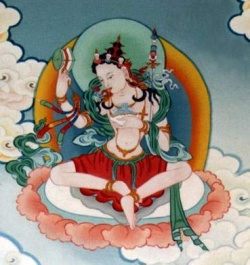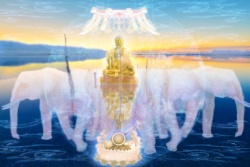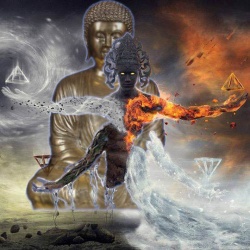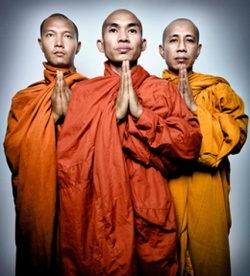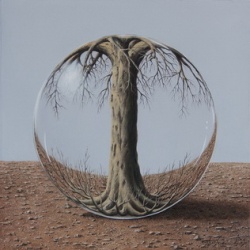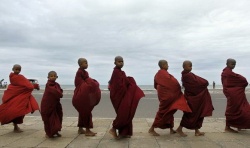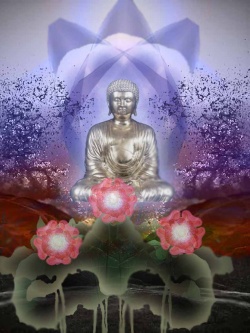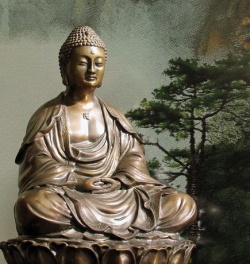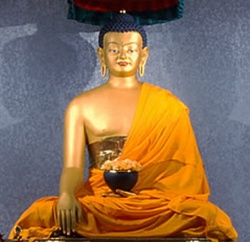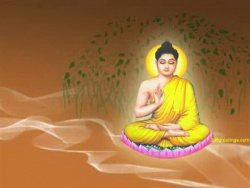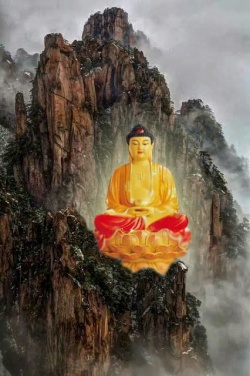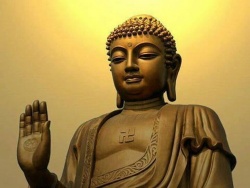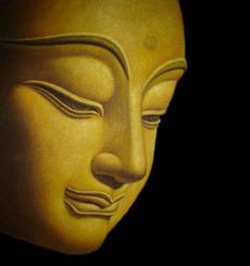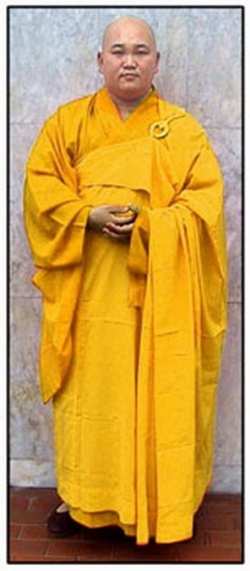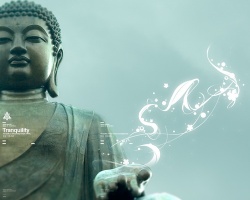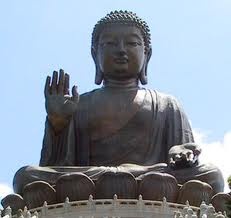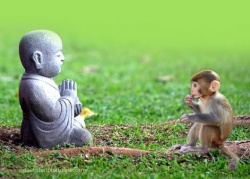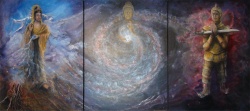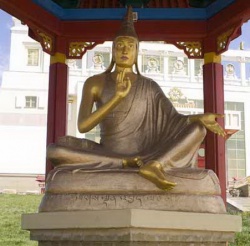Difference between revisions of "Modern Physics and Tibetan Buddhism"
m (Text replacement - "]]]" to "]])") |
|||
| (7 intermediate revisions by 3 users not shown) | |||
| Line 1: | Line 1: | ||
{{DisplayImages|4130|3318|1116|3365|4446|4315|3302|1364|1343|97|2269|2444|1965|3821|2828|4328|1929|3067|2995|748|3168|1385|2812|3062|2020|1864|2245|1738|2937|2367|989|930|4367|2262|2928|3504|4206|2463|1659|4036|575|4187|348|2090|2243|324|3069|1022|1416|1096}} | {{DisplayImages|4130|3318|1116|3365|4446|4315|3302|1364|1343|97|2269|2444|1965|3821|2828|4328|1929|3067|2995|748|3168|1385|2812|3062|2020|1864|2245|1738|2937|2367|989|930|4367|2262|2928|3504|4206|2463|1659|4036|575|4187|348|2090|2243|324|3069|1022|1416|1096}} | ||
| − | + | ||
SCIENTIFIC PARADIGMS AND THE THREE TURNINGS OF THE WHEEL: THE EVOLUTION OF COSMOLOGICAL CONCEPTS IN [[TIBETAN BUDDHISM]] | SCIENTIFIC PARADIGMS AND THE THREE TURNINGS OF THE WHEEL: THE EVOLUTION OF COSMOLOGICAL CONCEPTS IN [[TIBETAN BUDDHISM]] | ||
| − | + | J. McKim Malville | |
| Line 21: | Line 21: | ||
I. INTRODUCTION | I. INTRODUCTION | ||
| − | + | That the entire repertoire of [[human]] [[experience]] is fleeting and ever changing is a fundamental [[teaching]] of [[Buddhism]]. Not one of the [[objects]] of our [[world]], our [[perceptions]] of those [[objects]], our [[Wikipedia:concept|concepts]], or even our [[gods]] is [[eternal]]. Like the [[river]] of Heraclites, [[life]] is ever flowing and ever different, and [[suffering]] results when we [[cling]] to something that appears to be [[permanent]]. [[Human]] [[experience]] consists not of [[eternal]] ultimates and [[essences]], but of combinations, the parts of which are perpetually [[arising]] and perishing, just as the [[human body]] itself changes [[form]] [[moment]] to [[moment]]. The [[mind]] and [[consciousness]] appear and disappear, like day and night, like a monkey gamboling in a {{Wiki|forest}}, leaping from branch to branch. | |
| + | |||
| + | [[Buddhism]], as an [[ethical]] and [[philosophical]] system, has been no more exempt from continual change than anything else in our [[world]]. The [[evolution]] of [[Buddhism]] has been interpreted either as a process of [[constant]] [[development]] spurred by internal and external challenges, perhaps largely unforeseen by its founder, or as a complete and self-contained [[philosophy]] [[taught]] by the [[Buddha]] and elucidated by subsequent commentators. The [[latter]] [[interpretation]] is preferred by [[Tibetan Buddhists]] who describe the unfolding of [[Buddhism]] in terms of the [[three turnings of the Wheel of Dharma]]: | ||
| + | |||
| + | first, the [[scripture]] of [[Hinayana]]; second, the [[intermediate]] [[scripture]] of [[Mahayana]] including the [[Prajnaparamitas]] and the [[Madhyamika]]; third, the [[scripture]] of [[Yogacara]]. | ||
| + | |||
| − | |||
These three stages have been characterized respectively as: | These three stages have been characterized respectively as: | ||
| − | 1) Realism {{Wiki|emphasizing}} the "radical {{Wiki|pluralism}}" implicit in the [[reality]] of "[[psychological]] [[atoms]]" or [[dharmas]]; | + | |
| + | 1) [[Realism]] {{Wiki|emphasizing}} the "radical {{Wiki|pluralism}}" implicit in the [[reality]] of "[[psychological]] [[atoms]]" or [[dharmas]]; | ||
2) [[Dialectical]] [[criticism]] dominated by the [[concept of emptiness]] and by the towering figure of [[Nagarjuna]]; | 2) [[Dialectical]] [[criticism]] dominated by the [[concept of emptiness]] and by the towering figure of [[Nagarjuna]]; | ||
| Line 33: | Line 38: | ||
(3) {{Wiki|Idealism}} represented by the "[[absolutist]] {{Wiki|idealism}}" of Cittamatrin or the "[[mind only]]" school2. | (3) {{Wiki|Idealism}} represented by the "[[absolutist]] {{Wiki|idealism}}" of Cittamatrin or the "[[mind only]]" school2. | ||
| − | + | ||
| + | |||
| + | Interwoven throughout [[Buddhism]] are [[Wikipedia:concept|concepts]] that because of their [[physical]] or [[cosmological]] content fall into the [[realms]] claimed today by [[physics]] and [[cosmology]]. To a much greater extent than is [[experienced]] in {{Wiki|Western cultures}} today, these issues of [[cosmology]] find their way into the every-day [[lives]] of [[ordinary people]] as they [[experience]] the surrounding [[world]] and [[heavens]]. | ||
| + | |||
| + | A number of these [[Wikipedia:concept|concepts]] [[experienced]] major, {{Wiki|revolutionary}} transformations in successive [[turnings of the wheel]]. I shall explore some of those [[Wikipedia:concept|concepts]] that evolved through the [[three turnings]] and shall indicate how they may be described in the same [[language]] used to analyze {{Wiki|western}} [[science]]. In particular I shall suggest that the approach of the second turning has similarities to the positivism of Neils Bohr and his co-called Copenhagen School of {{Wiki|quantum physics}}, which approach is probably preferred by most {{Wiki|physicists}} today. | ||
| + | |||
| + | Furthermore, the third turning as represented by the [[Yogacara]] writings of [[Asanga]], may share many of the aspects of {{Wiki|modern}} critical {{Wiki|realism}}. | ||
| − | + | ===[[PARADIGMS OF NATURAL SCIENCE]]=== | |
| + | |||
| − | |||
| − | + | {{Wiki|Western}} [[science]] has also evolved through a number of {{Wiki|distinct}} stages, each described as a "{{Wiki|paradigm}}" by {{Wiki|Thomas Kuhn}} in his remarkably influential [[book]], The Structure of [[Scientific]] Revolutions. One of the [[essential]] aspects of the [[evolution]] of [[science]] as pointed out by Kuhn is its non-cumulative [[development]] and its and non-anticipatory quality. Old [[science]] such as {{Wiki|Aristotelian}} dynamics or [[Ptolemic]] {{Wiki|astronomy}} contained many [[beliefs]] that were incompatible with the ones we hold today. The old [[scientific]] [[beliefs]] were clearly wrong judged by current [[knowledge]] of [[physical phenomena]]. What is even more striking, the new [[science]] could never have been [[logically]] generated by the [[logical]] methods of the old. The new [[science]] would have been judged just as irrational by the standards of the old as we today [[judge]] the old. Of course, any claim that the [[earth]] is in the center of the {{Wiki|solar system}} would be "unscientific" today; a claim that the {{Wiki|sun}} is in the center of the {{Wiki|solar system}}, such as was made by Aristarchus, was also judged to be "unscientific" by the [[Aristotelians]]. | |
| + | |||
| + | If outmoded and rejected [[scientific]] [[Wikipedia:concept|concepts]] were not "unscientific" in their days, then it is difficult, Kuhn argues, to see the [[development]] of [[science]] as a process of [[accumulation]] and a steady {{Wiki|movement}} toward "[[truth]]". | ||
| + | |||
| + | The progress of [[science]] does not appear to be accumulative, continuous, or even progressive, for that {{Wiki|matter}}, but rather appears to occur through discrete jumps involving {{Wiki|revolutionary}} changes between successive [[scientific]] {{Wiki|paradigms}}. Kuhn primary uses the term {{Wiki|paradigm}} to mean exemplar: "standard examples of [[scientific]] work which embody a set of {{Wiki|conceptual}}, {{Wiki|methodological}} and [[metaphysical]] assumptions."3 In the process of becoming [[scientists]], students study and often mold themselves according to the research style of major paradigmatic figures, such as [[Newton]], [[Maxwell]], [[Bohr]], or [[Rutherford]]. | ||
| + | |||
| + | The ruling {{Wiki|paradigm}}, through example, establishes appropriate style of discovery, tests of validity, as well as [[language]] of [[communication]] among fellow [[scientists]] within the {{Wiki|paradigm}}. | ||
| + | |||
| + | There is the [[interesting]] possibility that the [[three turnings]] may actually reflect progressive developments of [[science]] in the [[Buddhist]] [[world]] during the millennium following [[death]] of the [[Buddha]]. In particular, [[Kloetzli]] has explored the possibility that "each of the [[Buddhist cosmologies]] is grounded in a particular [[scientific]] [[perception]] of reality".4 He suggests that the [[Madhyamikan]] {{Wiki|revolution}}, led by [[Nagarjuna]], is an example of the entry of "[[scientific]]" [[insights]] into {{Wiki|theology}}; the [[science]] has been lost and only the [[Madhyamikan]] {{Wiki|theology}} remains. | ||
| + | |||
| + | |||
| + | In fact, one can identify a number of possible [[elements]] of a highly relativistic [[scientific]] {{Wiki|paradigm}} that may have been {{Wiki|present}} in [[India]] at the [[time]] of [[Nagarjuna]]: | ||
| − | |||
1. rejection of [[absolute]] {{Wiki|motion}}; | 1. rejection of [[absolute]] {{Wiki|motion}}; | ||
| − | 2. [[recognition]] of [[relative]] {{Wiki|motion}} and the rotation of the [[earth]] | + | 2. [[recognition]] of [[relative]] {{Wiki|motion}} and the rotation of the [[earth]] and other [[world]] disks; |
| − | |||
| − | and other [[world]] disks; | ||
3. rejection of indivisible [[dharmas]]; | 3. rejection of indivisible [[dharmas]]; | ||
| Line 55: | Line 74: | ||
4. rejection of all absolutes of size, [[space]], [[time]], and number; | 4. rejection of all absolutes of size, [[space]], [[time]], and number; | ||
| − | 5. rejection of geocentricity and, in fact, even of | + | 5. rejection of geocentricity and, in fact, even of [[heliocentricity]]; |
| − | + | 6. [[assertion]] of the [[infinity of space]]; | |
| − | + | 7. replaced {{Wiki|emphasis}} on [[time]] of the [[Sarvastivadins]] with {{Wiki|emphasis}} on the [[ten directions]] of [[space]] | |
| + | |||
| + | 8. introduction of {{Wiki|light}} as a primary creative agent in the [[universe]]. | ||
| − | |||
| − | |||
| − | + | Many of these items are intriguing for their allusion to issues that are [[physical]] and [[astrophysical]] in [[nature]]. However, {{Wiki|evidence}} for an underlying [[science]] associated with the [[Madhyamikan]] {{Wiki|revolution}} is highly presumptive and circumstantial due to the lack of documentation of [[Buddhist]] "[[scientific]]" {{Wiki|cosmologies}}. | |
| − | |||
| − | + | In addition there is a very {{Wiki|ambiguous}} {{Wiki|distinction}} between [[cosmology]], [[science]], and {{Wiki|theology}} in [[Buddhism]]. [[Buddhist]] "[[science]]" would certainly not have been as neatly separated from the rest of {{Wiki|culture}} as it is presently separated in the [[West]]. In the first place, in [[Buddhism]], [[Wikipedia:Ontology|ontological]] issues, standard {{Wiki|western}} astronomical questions about the [[nature]] of the [[universe]], are always subservient to {{Wiki|practical}} [[ethics]] and {{Wiki|salvation}}. | |
| − | + | Furthermore, the [[cosmology]] of [[Buddhism]] is a total system in which astronomical [[cosmology]] and [[physics]] are inextricably intertwined with concerns for {{Wiki|salvation}}. Using the {{Wiki|terminology}} of Clifford Geertz 5, the map of the [[world]], for the [[Buddhist]], is not just a model of something external as it is in {{Wiki|Western}} [[science]], but it also is a model for effective living by an {{Wiki|individual}} and an entire {{Wiki|community}}. Further [[discussion]] of a possible [[Madhyamikan]] [[scientific]] {{Wiki|paradigm}} will be given in the section on the second turning. | |
| − | + | ===[[HUMAN EXPERIENCE AND SCIENTIFIC KNOWLEDGE]]=== | |
| − | |||
| − | |||
| − | + | One of the significant areas of overlap between [[Tibetan Buddhist]] [[philosophy]] and {{Wiki|western}} [[science]] is [[interpretation]] of [[human]] [[experience]] in the [[physical world]]. The relationship between a "[[subjective]]" [[human]] observer and an "[[objective]]" [[world]] are major concerns in both {{Wiki|western}} [[science]] and [[Buddhism]]. Are the [[scientists]], for example, "watchers" from a distance or are they participants who create a [[world]] as they investigate it? | |
| − | + | During the 1930's and 1940' there was an [[acceptance]] amongst [[philosophers]] of [[science]] of the positivist viewpoint that [[science]] starts from "[[pure]]" {{Wiki|data}} which are describable in a [[neutral]] [[language]] which is {{Wiki|independent}} of all theories.6 Since [[Hume]], [[Wikipedia:Positivism|positivists]] have argued that [[experience]] begins with the passive [[perception]] of momentary, disconnected, un-interpreted [[Wikipedia:Qualia|sensory data]]. That bare [[experience]] was viewed as "[[physical]] [[reality]]." According to this [[view]], the [[scientist]], separate from that which he is [[measuring]], collects [[objective]] {{Wiki|data}} and then [[forms]] inductive generalizations that we identify as theories. In the 1950's [[criticism]] of the positivist viewpoint moved slightly away from the [[belief]] in bare facts. The empiricists or critical [[Wikipedia:rationalism|rationalists]] such as [[Karl Popper]]7 argued that there were two levels in [[science]]: a lower, fundamental level of [[unchanging]], [[objective]] {{Wiki|data}} which were directly available to the [[senses]] which is completely [[non-conceptual]] and a second level of {{Wiki|theoretical}} [[Wikipedia:concept|concepts]] in which creative [[imagination]] of the [[scientist]] played an [[essential]] role in the formation of models and theories. | |
| − | + | In the 1960's a number of [[philosophers]] of [[science]] argued that there are no such things as [[pure]], un-interpreted {{Wiki|data}}. Expectations and {{Wiki|conceptual}} [[commitments]] influence [[perceptions]] in everyday [[life]] as well as in [[science]]. We supply the categories of [[interpretation]] at the very beginning of the process of {{Wiki|data}} collection. The [[language]] that we use in [[science]] depends upon the kind of regularities we expect to find. In the words of Hanson: "All {{Wiki|data}} are theory-laden."8 The dividing line between observation and {{Wiki|theory}} is not sharp or fixed. | |
| − | + | [[Kuhn]] has argued that the {{Wiki|data}} of observation and experiment were not {{Wiki|independent}} of the {{Wiki|paradigm}} and furthermore that the criteria used for assessing the validity of {{Wiki|theory}} were similarly influenced by the {{Wiki|paradigm}}. A shift of [[scientific]] {{Wiki|world view}} was not a [[calm]] and [[gradual]] [[evolution]] and growth of [[understanding]] but rather more one of [[conversion]] than [[logical]] argument. | |
| − | + | [[Scientists]] [[view]] the [[world]] through [[eyes]] influenced by the {{Wiki|paradigm}} in which they live. [[Newton]] saw the apple pulled downward by the force of {{Wiki|gravity}} while the [[Aristotelians]] saw the same [[phenomena]] as the apple seeking its [[natural state]]. The same situation can be seen in different ways as in an gestalt switch. Thus not only will [[scientists]] in different {{Wiki|paradigms}} collect different sorts of {{Wiki|data}}, but event viewing [[identical]] {{Wiki|data}}, they will come to different conclusions. Different {{Wiki|paradigms}}, argues Kuhn, solve address types of problems, often use different types of [[logic]], and rely upon different tests for "[[truth]]". | |
| + | |||
| + | {{Wiki|Modern}} critical realists(9) agree that [[experience]] in the [[world]] is strongly influenced by preconceptions and research strategies based upon the established {{Wiki|paradigm}} but insist that the full [[experience]] is the product of something which is encountered and a [[consciousness]] capable of apprehending and interpreting it. [[Consciousness]] has a selective [[interest]] in the [[world]] and a selective response to that [[world]] and is therefore an active agent, not merely a passive receiver. We supply the categories into which [[experiences]] and observations are fitted. However, although expectation, choices of [[objects]] of [[perception]], and analytical strategies strongly influence what we see, they do not entirely prevent [[perception]] of the unexpected: | ||
| + | |||
| + | |||
| + | |||
| + | "Our expectations strongly {{Wiki|structure}} what we see, but do not | ||
wholly eliminate unexpected sights....Our categorizations and | wholly eliminate unexpected sights....Our categorizations and | ||
| Line 99: | Line 121: | ||
and not in others. Yet they do not [[blind]] us to the unforeseen." 10. | and not in others. Yet they do not [[blind]] us to the unforeseen." 10. | ||
| − | + | ||
| + | |||
| + | The respective contributions of observer and [[external world]], of [[subject]] and [[object]] are thus never completely separable. The [[world]] is not purely [[subjective]]. There is a portion which is given to us, which we seem powerless to alter totally and which often places demands upon us to which we must conform. To live in the [[world]] fully, to understand its richness, we can not merely think about it. We must thoroughly investigate it and allow ourselves to be surprised by it. | ||
| − | + | ===[[TENACITY AND COMMITMENT]]=== | |
| − | |||
| − | |||
| − | + | [[Kuhn]] sees commitment to "research programs" as a important aspect of [[scientific]] {{Wiki|paradigms}}: a particular model is assumed to be correct and its implications are thoroughly explored throughout the material [[world]]. The [[scientist]] proceeds with his or her reigning {{Wiki|paradigm}} with a kind of [[faith]] that it will work, for only if it is not abandoned too quickly when apparent failures occur will its potentialities be explored. Failures are neglected in this approach as it is more important to discover the power and breadth of applicability of the {{Wiki|theory}} than its few areas which it apparently does not fit. Often fits are made by ad hoc {{Wiki|hypothesis}} and the discrepancy is understood to be merely [[illusory]]. Examples of research programs are those which proceeded to show that the [[universe]] could be treated by {{Wiki|Newtonian physics}} as a mechanical system or that instituted by Bohr to show that all [[atomic]] systems could be treated by {{Wiki|quantum mechanics}}. As I shall suggest in the [[discussion]] of the second turning, the approach of the [[Prasangika Madhyamika]] in their systematic testing of every aspect of the [[world]] for "[[true existence]]" has the [[character]] of an ambitious research program that is approached in the [[spirit]] of {{Wiki|modern}} [[physics]]. | |
| − | + | [[Paradigms]] contain models and {{Wiki|metaphors}} which are accepted as explanation and puzzle solutions. Questions of "why" are answered either by reference to established, analogical models or through identification of initial assumption but not by reliance upon "[[Wikipedia:Absolute (philosophy)|ultimate]]" [[truths]]. There are no [[ultimate truths]] in [[science]] as that no proposition can ever be proven fully true. The act of the [[scientist]] within a {{Wiki|paradigm}} is of three basic sorts: the discovery of new aspects of the [[phenomenal world]], the demonstration that those aspects are consistent with the reigning {{Wiki|theory}}, or the demonstration that a {{Wiki|theory}} is in conflict with the [[phenomenal world]] and hence must be discarded. Nowhere in [[science]] is there an attempt to prove as true a particular {{Wiki|theory}}. | |
| − | + | [[Scientists]], according to Kuhn, resist {{Wiki|paradigm}} revolutions because previous [[commitments]] have permeated all their [[thinking]]. The new [[scientific]] {{Wiki|revolution}} is complete only when the older [[scientists]] have either been `converted' or have [[died]] off. In his subsequent writings [[Kuhn]] has softened his initial [[belief]] in the total incommensurability of {{Wiki|paradigms}}. [[Communication]] between different {{Wiki|paradigm}} communities is possible, he suggests: `Both their everyday and most of their [[scientific]] [[world]] and [[language]] are shared. Given that much in common, they should be able to find out a great deal about how they differ.'11 The problem, as Kuhn sees its, is similar to that of translation between two [[language]] and {{Wiki|cultural}} communities, which is difficult in part and perhaps impossible in total. Using the analogy with [[language]], the [[conversion]] of a [[scientist]] to a new {{Wiki|paradigm}} would then correspond to [[abandonment]] of mere translation of another [[language]] to the complete adoption of the new [[language]] in which one [[thinks]] and speaks. | |
| + | The [[three turnings]] of the [[wheel]] do reveal different [[worlds]] and do suggest radically different ways of dealing with [[experience]], but they not appear to correspond to in-commensurate {{Wiki|paradigms}}; they appear to be considerably more accumulative than is the case of [[scientific]] {{Wiki|paradigms}}. The incommensurability of [[scientific]] revolutions is a highly controversial [[assertion]] of Kuhn. He argued that a new {{Wiki|paradigm}} does not merely add to the old {{Wiki|paradigm}} but actually replaces it. The [[transformation]] from {{Wiki|Aristotelian}} to {{Wiki|Newtonian physics}} was a `[[transformation]] of the [[scientific]] [[imagination]]' in which old {{Wiki|data}} were seen in entirely new ways. The very means for testing for [[truth]] and the [[logic]] of discovery and analysis, may be totally different and hence incommensurate from one {{Wiki|paradigm}} to the next. | ||
| + | |||
| + | The second and third turnings do not abandon and nullify the teachings of the earlier turnings, but build upon them in a [[manner]] which is indeed quite in contrast to {{Wiki|western}} [[science]]. The highly "{{Wiki|practical}}" {{Wiki|training}} of a {{Wiki|modern}} [[scientist]] does not typically include a study of pre-Newtonian {{Wiki|paradigms}} nor the history of {{Wiki|western}} [[science]] which topics are considered irrelevant to the pursuit of [[scientific]] research. [[Buddhists]] [[respect]] the {{Wiki|totality}} of [[Buddhist]] [[sutra]], but relegate different portions to either provisional {T. drang.ton} or final {T. ngl.ton} teachings. The [[Hinayanists]] [[view]] the first turning as final and the second and third as [[provisional teachings]] while the second turning for the [[Prasangikas]] is understood to be final and the Yogacains see third as final. For many [[Tibetan Buddhists]], full [[knowledge]] of all [[three turnings]] is considered necessary. | ||
| − | + | ===[[THE FIRST TURNING]]=== | |
| − | |||
| − | + | ||
| + | The [[philosophical]] position of the first turning was {{Wiki|realistic}} and, in a [[sense]], mechanistic. [[Reality]] was identified by the [[Sarvastivadans]] ([[Sanskrit]]: [[sarvam asti]], everything [[exists]]) as fundamental "[[dharmas]]" and is presented in [[Abhidharmakosha]] written by [[Vasubandhu]] in the 4th Century A.D. The [[Sarvastivadans]] [[affirmed]] the composite [[existence]] of external [[objects]] and the substantial [[existence]] of {{Wiki|past}}, {{Wiki|present}}, and future12. Most significantly they [[constructed]] a [[world]] "beneath" our [[world]] of sensory [[phenomena]] which consists of [[elemental]] and discrete [[psychological]] [[experiences]] called [[dharmas]]. These [[psychological]] [[elements]] were considered real for they are timeless and underived. They [[exist]] by their [[own]] right, a common ground of the variety of [[experience]], {{Wiki|independent}} and self-contained. Thus [[reality]] can be described {{Wiki|independently}} from the [[self]] and [[ego]]. [[Attachment]] to [[self]] is one of the fundamental sources of [[suffering]] according to the [[Buddha]]. When one searches for the "[[self]]" which appears to [[truly existent]], one finds not find the [[self]] but only its components, the underlying [[dharmas]]. | ||
| + | |||
| + | While [[dharmas]] themselves do not [[exist]] in [[time]], their [[function]] is {{Wiki|temporal}}. They rise to [[function]], carry out that [[function]], and then cease to [[function]]. The fundamental unit of [[time]] is the minimum conceivable [[time]] for the [[dharma]] to rise to [[function]]. Each unit of [[function]] is separate and {{Wiki|distinct}}. {{Wiki|Movement}} is the result of a series of discrete, momentary flashings of separate [[essences]]. {{Wiki|Motion}} is thus not continuous but divisible into a series of separate units. Thus although the [[world]] encountered by our [[senses]] is [[empty]] of [[true existence]] in the [[sense]] that is always changing, [[compounded]], and [[dependent upon]] [[causes and conditions]], there is underlying our experiential [[reality]] a timeless [[substratum]] containing fundamental [[elements]] which can be neither cut or destroyed. | ||
| − | + | ===[[THE SINGLE WORLD DISK]]=== | |
| + | |||
| + | |||
| − | + | The model of the [[universe]] which is presented in the Abidharmakosa is that of a [[world]] disk with the great [[cosmic]] mountain, [[Mt. Meru]], situated in the center surrounded by seven rings of [[mountains]] and oceans. The {{Wiki|sun}}, [[moon]], and {{Wiki|stars}} revolve about [[Mt. Meru]]. We live on the southern of four major continents {{Wiki|lying}} in the seventh ocean beyond the seventh ring of [[mountains]]. Our disk floats on an ocean supported by [[winds]] which arise out of [[space]]. There may or may not be other [[world]] disks separated from ours by [[empty]] [[space]], but our [[world]] disk is the central one, the [[Buddha field]] {[[buddhaksetra]]} looked over by [[Buddha Sakyamuni]]. | |
| − | + | The {{Wiki|drama}} of {{Wiki|salvation}} for the [[Hinayana]] of the first turning is that of a [[shravaka]] (hearer) or [[pratyekabuddha]] ([[solitary realizer]]) as he or she moves upward through the successive [[heavens]] above [[Mt. Meru]]. The [[Mt. Meru]] [[cosmology]] has the {{Wiki|structure}} of a {{Wiki|space-time}} diagram with [[time]] extending along the vertical axis and [[space]] expanding outward from the central mountain in seven successive rings. | |
| − | + | The [[cosmological]] model of the first turning was geocentric and [[absolutist]]. The [[earth's]] disk was "absolutely" in the center; our disk was unique in that it possessed a [[Buddha]]. [[Human]] [[experience]] arose from [[absolute]] and indivisible [[dharmas]] forming a common ground for the rising and falling of particular events. The [[cosmology]] was certainly pre-Copernican in its assumed centrality of our [[world]] disk, although because the continent on which we live, [[Jambudvipa]], was in the seventh ocean, there was a peripheral quality to our [[experience]] which was certainly not shared with the highly geocentric [[cosmos]] of the [[Greeks]]. | |
| − | + | The {{Wiki|world view}} assumed by the first turning was similar to that of a [[scientific]] realist who assumes that [[scientific]] theories are accurate descriptions of the [[world]] as it actually [[exists]]. The realist believes that the entities such as {{Wiki|mass}}, force, charge, [[atoms]], etc postulated in theories do fully [[exist]] even though they may not be directly observable. The real is thus is not necessarily the perceptible; indeed, for the [[Hinayana]] the perceptible is [[empty]] of [[true existence]]. But there is is a real which [[exists]] in an [[objective]] relationship to [[human]] [[experience]], namely the underlying [[dharmas]]. [[Realists]] affirm that being is prior to [[knowing]] and that [[knowledge]] converges upon that being. | |
| − | + | ===[[THE SECOND TURNING]]=== | |
| + | |||
| + | |||
| + | |||
| + | The second turning represented a major and dramatic shift away from the {{Wiki|realism}} and process of {{Wiki|solitary}} [[enlightenment]] of [[Hinayana]]. The towering figure of the second turning is [[Nagarjuna]] who lived in the second century A.D.. For [[Nagarjuna]] the error of misplaced absoluteness13 was one of the main [[causes of suffering]] in the [[world]]. The common [[human]] [[thirst]] for the [[absolute]] and the infinitely varied struggles to find and [[grasp]] the absolutes produs greater and greater [[suffering]] and [[frustration]]. | ||
| − | + | My approach to the second turning will be primarily that of the [[Prasangika Madhyamika]] school. Their basic position is that there is no [[object]], [[self]], or [[phenomenon]] whose [[Wikipedia:Absolute (philosophy)|ultimate]] [[nature]] is not "[[emptiness]] or [[voidness]]". The terms "[[empty]]" and [[void]]" are short-hand for the proposition that all [[phenomena]] and selves are [[empty]] of [[true existence]]. The term, "[[true existence]]" is carefully defined as meaning a [[state]] (1) which is {{Wiki|independent}} of all external [[causes and conditions]], (2) which possesses a self-existence "from its [[own]] side" {{Wiki|independent}} of names and categories which are imposed upon its, either deliberately or instinctively by the [[mind]], and (3) which is [[eternal]] and [[unchanging]]. The basic proposition of the second turning is that one can not find either an aspect of oneself or of any [[phenomena]] which is [[truly existent]] as it is so defined. The [[sanskrit]] term for [[emptiness]] is [[sunyata]] which comes from [[root]] [[svi]] meaning to swell. The implication is that our [[sense]] of our selves is not only swollen in [[self-esteem]] but hollow and [[empty]] inside. If we search for the [[heart]] or [[essence]] of a swollen and bloated fruit which has been {{Wiki|lying}} rotten in the {{Wiki|sun}} for some [[time]], we find only hollowness and [[empty]] [[space]]. | |
| − | + | [[Reality]] can only be described using the non-affirming {{Wiki|negation}} [prasajya pratisedha]. A {{Wiki|distinctive}} [[character]] of the second turning was the scrupulous avoidance of any positive statement about [[reality]]. The only secure [[knowledge]] that we possess is that nothing is completely {{Wiki|independent}} and [[unchanging]]. The lack of [[true existence]] of [[phenomena]] is the only statement that can be made; no positive implications of an [[existent]] [[reality]] can be [[affirmed]]. | |
| − | + | There is a strong hint of the [[infinity]] and [[interdependent]] [[nature]] of the [[world]] in the second turning. But, it is only a hint. Positive statements about [[reality]] can not be [[Wikipedia:Authenticity|authentic]]. [[Reality]] is so [[infinite]] and so mutually [[interdependent]] that [[Wikipedia:Authenticity|authentic]] portions can not be captured. Scraps can not be cut out of the whole tapestry of [[reality]] without causing the unraveling of the cloth. Absolutely valid statements can not be made by us, for the [[infinite]] can not be grasped or authentically divided. But [[infinity]], itself, can also only be hinted, as it is only a provisional {{Wiki|concept}}; the [[infinite]] also is [[empty]] of true existence.14 | |
| − | + | The [[Prasangika Madhyamika]] follow closely the teachings of [[Nagarjuna]] in denying the [[true existence]] everything which can be identified. Known as the Consequence School, the [[Prasangika]] excel in [[debate]]. Their [[debating]] style is to carry every positive [[assertion]] to its absurd consequence, a {{Wiki|reductio ad absurdum}}. They do not concede that [[phenomena]] [[exist]] {{Wiki|independently}} evenly {{Wiki|conventionally}}, for all [[phenomena]] are compounds and therefore [[subject]] to [[dependent origination]] ([[pratitya samutpada]]) from extrinsic [[causes and conditions]]. | |
| − | + | When we search for [[phenomena]] which sometime appear to be so definite and clearly [[existence]], we discover that they do not survive under "[[Wikipedia:Absolute (philosophy)|ultimate]] analysis" by which the [[Prasangika Madhyamika]] mean a highly ruthless search, in which no quarter is given, for the [[essence]] or [[true existence]] of a thing. For, where exactly is the [[essence]] of a [[flower]], a rock, or a {{Wiki|frog}}? The [[essence]] of the [[flower]] is not in the petals, the [[roots]], the {{Wiki|scent}}, the stamen, the {{Wiki|color}}; the [[essence]] is nowhere to be found. It is neither in the [[flower]] nor is it not in the [[flower]]. It is unfindable although no one can [[doubt]] that {{Wiki|conventionally}} the [[flower]] certainly [[exists]]. | |
| − | + | A highly important aspect of the [[Prasangika]] strategy, which can not be overemphasized, is that one must be very specific about [[emptiness]] and what it is that can not be found. [[Emptiness]] does not mean that [[phenomena]] do not [[exist]]; [[emptiness]] must refer to a particular [[object]] and must specify what the [[object]] is [[empty]] of. The fundamental statement of the second turning that all things which can be identified or named are [[empty]] of [[true existence]]. No such statement is made about that which can not be identified. | |
| − | + | All [[objects]] in the [[world]] which can be identified must be investigated with care and precision to demonstrate their lack of [[true existence]]. Such careful [[investigation]] of [[phenomena]] and ones [[self]] has been made into a [[meditative]] technique by the [[Prasangika Madhyamika]], as they test the {{Wiki|hypothesis}} that no [[phenomenon]] can be found which has [[true existence]]. However, the [[Prasangika]] [[Madhyamikas]] assert that one must be very careful first to identify the [[object]] which one is investigating. It is not proper to issue a general statement that all aspects of the [[universe]] are lacking in [[true existence]]; the {{Wiki|prediction}} by the [[Prasangika]] is limited only to identifiable [[objects]], [[objects]] to which we can give names or [[phenomena]] which have a basis which can be identified. Another [[form]] of the {{Wiki|prediction}} of [[Prasangika]] is that once one has identified an [[object]] or a [[phenomenon]], it is ultimately not findable, that is, it does not [[exist]] as a single, "[[atomic]]" or fundamental [[object]], precisely localizable in {{Wiki|space and time}}. | |
| − | + | The [[Prasangika Madhyamika]] identify two "[[truths]]", [[Wikipedia:Absolute (philosophy)|ultimate]] and [[Wikipedia:Convention (norm)|conventional]]. The [[phenomena]] of the [[world]] are understood to [[exist]] {{Wiki|conventionally}}, to obey laws which are {{Wiki|conventionally}} true and to [[function]] according to the "infallible [[laws of cause]] and effect." When these [[two truths]] or natures "are seen to be non-contradictory then we have understood the `unification' of the two truths."_15_ All [[phenomena]] have two modes of [[existence]]: [[Wikipedia:Convention (norm)|conventional]] and [[Wikipedia:Absolute (philosophy)|ultimate]], of which [[voidness]] or [[emptiness]] is the [[Wikipedia:Absolute (philosophy)|ultimate]] [[nature]] of being. [[Conventional truth]] deals with our everyday [[experiences]] and expresses the [[interdependence]] between a valid basis for [[imputation]] and a valid imputing [[consciousness]]. The [[ultimate truth]] is that all things and selves are [[empty]] of [[true existence]]. A popular example of invalid imputations is that of the mistake of a coil of rope for a {{Wiki|snake}} or a pile of rocks for a [[person]]. Neither the pile or rock nor the rope can [[function]] properly as {{Wiki|snake}} or [[person]], respectively, and hence are judged as invalid._16_ Such a quasi-experimental approach advocated by the [[Madhyamikans]] in which predicted [[function]] of an [[imputation]] is used to [[judge]] its validity is similar to the standard [[inductive-deductive]] strategy of {{Wiki|modern science}} as well as to that of {{Wiki|modern}} empiricists such as Karl Popper who insist that discordant {{Wiki|data}} falsify theories. According to Popper, an inductive {{Wiki|theory}} is judged to be valid on the basis of the agreement between predicted qualities and test by experimental fact, and is rejected if it fails the "test of fact". In [[Madhyamikan]] terms, if the [[imputation]] does not [[function]] appropriately, it is not only not [[truly existent]] is simply {{Wiki|non-existent}}. | |
| + | |||
| + | |||
| + | There are three levels of [[imputation]] for the coil of rope-snake combination: | ||
| − | |||
| − | |||
1. The {{Wiki|snake}} is {{Wiki|non-existent}} as a coil of rope has been mistaken | 1. The {{Wiki|snake}} is {{Wiki|non-existent}} as a coil of rope has been mistaken | ||
for the {{Wiki|snake}} as is discovered upon closer inspection. | for the {{Wiki|snake}} as is discovered upon closer inspection. | ||
| + | |||
| + | |||
2. The {{Wiki|snake}} was actually a {{Wiki|snake}} in the grass but the {{Wiki|snake}} is | 2. The {{Wiki|snake}} was actually a {{Wiki|snake}} in the grass but the {{Wiki|snake}} is | ||
| Line 167: | Line 203: | ||
given a [[self-existent]] [[nature]]; one is deceived when one believes | given a [[self-existent]] [[nature]]; one is deceived when one believes | ||
| − | that the is [[truly existent]], [[dangerous]], and [[evil]] in its own right | + | that the is [[truly existent]], [[dangerous]], and [[evil]] in its [[own]] right |
| − | and from its own side. | + | and from its [[own]] side. |
| − | 3. The {{Wiki|snake}} is accepted as a {{Wiki|snake}} without any assumptions of | + | |
| + | |||
| + | 3. The {{Wiki|snake}} is accepted as a {{Wiki|snake}} without any {{Wiki|assumptions}} of | ||
[[goodness]] or badness or without any [[inherent]] [[self-nature]]. The | [[goodness]] or badness or without any [[inherent]] [[self-nature]]. The | ||
| Line 179: | Line 217: | ||
a [[conventional truth]]. But, even though {{Wiki|conventionally}} true, the | a [[conventional truth]]. But, even though {{Wiki|conventionally}} true, the | ||
| − | {{Wiki|snake}} is deceptive as it still appears in a [[manner]] different from | + | {{Wiki|snake}} is deceptive as it still appears in a [[manner]] different from its actual [[existence]]. |
| − | |||
| − | |||
| − | + | According to the [[Prasangika]], [[objects]] of [[sense consciousness]] such as the {{Wiki|snake}} or rope are external to the perceiving [[consciousness]]. These [[objects]] are the [[cause]] of the [[arising]] of a [[sense consciousness]]; [[sense consciousness]] could not arise as an effect without a preceding [[causes]]. | |
| − | + | An [[ultimate truth]] is understood by a direct valid [[perception]] in which all [[dualistic]] [[appearances]] have subsided: deceptive [[truth]] can be understood by a direct valid [[perception]] in which [[dualistic]] [[appearances]] have not subsided. A [[dualistic]] [[appearance]] is that of an [[object]] together with its apparent [[inherent]] [[existence]]. | |
| + | |||
| + | If [[forms]] do not [[exist]] in the way they appear they are deceptive and not [[truly existent]], for to be [[truly existent]] means that [[forms]] just appear and [[exist]] in the same way. In the [[Prasangika view]] of [[reality]] there is only one thing is which is [[truly existent]] and that is the [[emptiness]] of all selves and [[phenomena]]. | ||
| − | + | ===[[UNCERTAINTY AND COMPLEMENTARITY]]=== | |
| + | |||
| + | |||
| − | + | There is a fascinating similarity between the approach to [[physical]] [[experience]] of the second turning and that of the so-called Copenhagen School of {{Wiki|Quantum Mechanics}} fathered by Neils Bohr. This approach is probably that held today by most {{Wiki|physicists}} who think about such matters. The Copenhagen School's [[representation]] of [[physical]] [[reality]] may approached through the famous {{Wiki|Uncertainty Principle}} of Heisenberg, which states that one can not know simultaneously and with [[Wikipedia:Absolute (philosophy)|ultimate]] precision both the position and {{Wiki|velocity}} of a {{Wiki|particle}}. Most {{Wiki|physicists}} are convinced that such uncertainty is not a result of temporary [[ignorance]], but is a fundamental limitation on [[human]] [[knowledge]]. One [[form]] of such [[ignorance]] is that it is introduced by the actual process of observation, by our presence in the [[world]]. Every act of questioning alters the situation since there is always a minimal interaction between the observer [who should be identified as a participant rather than separate, isolated observer] and the observed. Because the {{Wiki|disturbance}} of that which is external is unavoidable, one can never know the observed. | |
| − | + | Another [[form]] of uncertainty in [[physics]] results from our {{Wiki|conceptual}} limitations which Bohr maintains are inescapable. Concepts are derived from our everyday [[experience]] and we have a limited number of such [[Wikipedia:concept|concepts]], which are inadequate to describe the alien [[world]] of the {{Wiki|atom}}, for instance. Because we try to force the {{Wiki|non-human}} [[world]] into our {{Wiki|conceptual}} molds we encounter the [[paradox]] of the {{Wiki|Uncertainty Principle}} in {{Wiki|Quantum Mechanics}}. These [[Wikipedia:concept|concepts]] are useful in enabling one to make [limited] predictions about the [[atomic]] [[world]], but they are not the real nor even {{Wiki|representations}} of the real. Thus, the {{Wiki|physicist}} would agree with the statement that the {{Wiki|atom}} is indeed [[empty]] of [[true existence]] for it is built out of "flawed" [[experience]] due to an {{Wiki|inseparability}} between the observer and the observed and the inadequacy of "local" [[Wikipedia:concept|concepts]] to apply to other [[realms]] of [[reality]]. | |
| − | + | Closely related to the meaning of the {{Wiki|Uncertainty Principle}} is the wave-particle [[dualism]] of {{Wiki|electrons}} as well as {{Wiki|light}}. In some situations {{Wiki|electrons}} and {{Wiki|light}} behave as waves; in other they clearly and unambiguously behave as if they were {{Wiki|particles}}. | |
Bohr used the term complementarity to describe such {{Wiki|paradoxical}} {{Wiki|behavior}}: | Bohr used the term complementarity to describe such {{Wiki|paradoxical}} {{Wiki|behavior}}: | ||
| − | + | "However far the [[phenomena]] transcend the scope of classical | |
[[physical]] explanation, the account of all {{Wiki|evidence}} must be | [[physical]] explanation, the account of all {{Wiki|evidence}} must be | ||
| Line 231: | Line 271: | ||
possible [[information]] about the subjects."17 | possible [[information]] about the subjects."17 | ||
| − | + | Bohr's argument consists of the following points: | |
| + | |||
| + | |||
a. However alien [[phenomena]] may be involving microscopic spaces of | a. However alien [[phenomena]] may be involving microscopic spaces of | ||
| Line 242: | Line 284: | ||
[[experience]]. | [[experience]]. | ||
| + | |||
| + | |||
b. Because we are participants and not separate, uninvolved | b. Because we are participants and not separate, uninvolved | ||
| Line 248: | Line 292: | ||
[[experience]] is impossible. | [[experience]] is impossible. | ||
| + | |||
| + | |||
c. Every attempt we make to explore more deeply and with | c. Every attempt we make to explore more deeply and with | ||
| Line 258: | Line 304: | ||
[[phenomena]] we are striving to understand. | [[phenomena]] we are striving to understand. | ||
| + | |||
| + | |||
d. [[Experience]] obtained from a single set of [[experiences]] or mode | d. [[Experience]] obtained from a single set of [[experiences]] or mode | ||
| Line 267: | Line 315: | ||
exhaust the potential [[information]] associated with that [[phenomena]]. | exhaust the potential [[information]] associated with that [[phenomena]]. | ||
| − | + | ||
| + | |||
| + | The Copenhagen School asserts that in finite [[human]] [[experience]] one can never achieve final and total [[knowledge]] of the [[world]]. Our [[knowledge]] of the [[atomic]] [[realm]] is fatally flawed because of the participatory quality of our [[experience]] and our {{Wiki|conceptual}} limitations. According to Bohr's [[thinking]] our problems are not merely temporary but shall always be with us. No {{Wiki|matter}} how many experiments we perform, no {{Wiki|matter}} how sophisticated our equipment becomes, every [[time]] we attempt to [[measure]] simultaneously the {{Wiki|velocity}} and position of an {{Wiki|electron}} we shall discover the that {{Wiki|electron}} as a discrete {{Wiki|particle}} with the {{Wiki|behavior}} of a billiard ball does not [[exist]]. The early model of the [[atoms]] which [[imagined]] it as a miniature {{Wiki|solar system}} with particle-like {{Wiki|electrons}} in {{Wiki|orbit}} around the nucleus could be [[visualized]]. But the {{Wiki|modern}} {{Wiki|atom}} which has emerged from {{Wiki|quantum physics}} is not picturable at all. Pictures in one's head of {{Wiki|probability}} functions and oscillating waves do not help very much. The {{Wiki|atom}} and its {{Wiki|electrons}} are both inaccessible to direct observation and unimaginable in terms of our five or [[six senses]]. They can not be [[conceptualized]] in terms of [[space]], [[time]], [[causality]], and {{Wiki|mass}}. The domain of the very small is fundamentally different from the [[world]] of ordinary [[human]] [[experience]]. of {{Wiki|quantum mechanics}}. In [[physics]], there is a strong encouragement to repeat the search for the billiard-electron in as many different circumstances as possible to affirm and re-affirm the uncertainty [[relation]] and the fact that it is un-findable and does not [[exist]]. In a like [[manner]], the [[Prasangika Madhyamika]] is encouraged to seek everywhere and in every situation confirmation and re-confirmation that every [[phenomena]] is similarly lacking in [[true existence]]. Both are "research programs" devoted to demonstrating our inability to conceptualize the [[truly existent]]. | ||
| − | + | ===[[INFINITE SPACE]], [[INNUMERABLE WORLDS]]=== | |
| − | + | ||
| + | |||
| + | A highly dramatic change in the [[cosmological]] [[view]] is associated with the second turning. Because of its non-absolutist approach, the [[Prasangika Madhyamika]] could not claim that our [[world]] disk was central, unique, nor the major domain of the [[Buddha]]. Hence the [[cosmos]] was [[transformed]] into [[boundless space]] containing [[unlimited]] numbers of [[world]] disks, each with their [[cosmic]] mountain, none at a center or at an edge, none {{Wiki|superior}}, each associated with a [[Buddha]]. There can be no [[absolute]] requirements on sizes of the [[worlds]] and consequently other [[worlds]] may be both infinitesimal and immense compared to ours. Such a non-geocentric and non-heliocentric model is a remarkable leap of [[thought]], considerably closer to {{Wiki|modern}} astrophysics than were the models of contemporary {{Wiki|Greek}} [[world]]. | ||
Indeed the vastness of the second turning [[cosmos]] exceeded the [[vision]] of {{Wiki|western}} astronomers until this century. Astrophysical [[cosmology]] today is based on a fundamental assumption known as the "[[Cosmological]] [[Principle]]" that the large scale features of the [[universe]] are [[identical]] when viewed from all possible locations. Thus we do not assume that our location is unique in any way whatsoever; our observations made from [[Earth]] and from our {{Wiki|galaxy}} thus are typical and generic. | Indeed the vastness of the second turning [[cosmos]] exceeded the [[vision]] of {{Wiki|western}} astronomers until this century. Astrophysical [[cosmology]] today is based on a fundamental assumption known as the "[[Cosmological]] [[Principle]]" that the large scale features of the [[universe]] are [[identical]] when viewed from all possible locations. Thus we do not assume that our location is unique in any way whatsoever; our observations made from [[Earth]] and from our {{Wiki|galaxy}} thus are typical and generic. | ||
| − | + | Between our [[world]] and the {{Wiki|innumerable}} other [[worlds]] there is simply [[space]] which is understood by the [[Prasangika Madhyamika]] to be the absence of obstructive [[contact]] 18. [[Space]] is considered to be a [[permanent]] [[phenomena]] ([[nitya]]) which does not disintegrate with [[time]]. Although [[space]] is considered by the [[Buddhists]] to be the fifth [[element]], in addition to [[earth]], [[fire]], [[air]], and [[water]], [[space]] can be [[Wikipedia:Cognition|cognized]] only by our [[mental consciousness]] since all [[phenomena]] composed of the four "lower" [[elements]] which can be contacted by the [[five physical senses]] are [[impermanent]]. [[Space]] is considered to be [[unconditioned]] since it does not depend upon external [[causes and conditions]]. | |
| − | + | [[Space]] is all pervading since it is non-obstructive everywhere; solid [[objects]] could not [[exist]] in [[space]] unless it was non-obstructive without limit. As a non-affirming negative [no positive thing is implied in its place] [[space]] is similar to [[the ultimate truth]] that all [[phenomena]] are [[empty]] of [[true existence]]. It is asserted that similar to [[emptiness]], [[space]] has its parts because each [[object]] has an associated lack of obstructive [[contact]] just as it each [[object]] has a lack of [[true existence]]. [[Space]] is thus used by the [[Prasangika Madhyamika]] as an analogical model for [[emptiness]]. There is a slight {{Wiki|distinction}} which is made between [[emptiness]] and [[space]] such that [[space]] is known to be a non-occasional [[permanent phenomenon]] while [[emptiness]] is an occasional [[permanent phenomenon]]. The [[emptiness]] of a [[book]], for example, is comes into being when the [[book]] is created and disappears when the [[book]] disappears. While the [[book]] is {{Wiki|present}} as a [[Wikipedia:Convention (norm)|conventional]] [[phenomenon]], its [[emptiness]] does not change or disintegrate. As a general quality, [[emptiness]] is always {{Wiki|present}}, as there never is a [[time]] when there is not an example of [[emptiness]]. Similarly, [[space]] has been {{Wiki|present}} since "[[beginningless]] [[time]]". | |
| − | + | ===[[MADHYAMIKAN PARADIGM]]=== | |
| − | |||
| − | + | The second turning represents a curious leap from {{Wiki|realism}} and [[world]] [[affirmation]] of the first turning to the {{Wiki|sceptical}} and negativistic [[attitude]] of [[Nagarjuna]]. In the 2nd Century A.D. [[Buddhism]] thus shifted away from a {{Wiki|common sense}} approach to [[phenomena]] to a more {{Wiki|subtle}} and non-picturable [[appreciation]] of [[reality]]. Apparently [[Nagarjuna]] did not intend to produce a new {{Wiki|paradigm}} nor [[metaphysics]] but instead to develop an approach to [[life]] involving an all embracing {{Wiki|scepticism}} of all models and [[Wikipedia:concept|concepts]]. The technique was certainly negative in its [[criticism]] of incomplete [[Wikipedia:concept|concepts]] and relatives mistaken for absolutes, but [[Nagarjuna's]] goal was not [[Wikipedia:Nihilism|nihilistic]] but that of freeing the [[mind]] from [[attachment]] to old [[Wikipedia:concept|concepts]]. His encouragement was to give the [[mind]] freedom to explore the depths of [[experience]] and to penetrate new [[realms]] closed by a too rigid [[view]] of [[reality]]. | |
| + | |||
| + | Such a {{Wiki|sceptical}} approach to established models and the advocacy of [[intellectual]] freedom is highly reminiscent of Einstein's description of his approaches leading to the theories of relativity.19 However, to claim that [[Nagarjuna]] anticipated many of the aspects of {{Wiki|modern}} [[relativity]] is unjustified. [[Nagarjuna's]] rejection of [[absolute]] {{Wiki|motion}} was partly due to his rejection of the [[Sarvastivadan's]] reliance upon [[absolute]] [[dharmas]] and their consequent discrete [[appearance]] in the [[world]]. {{Wiki|Motion}} according to the Sarvastivadan's could not be continuous and hence had no genuine [[existence]]. Einstein's rejection of [[absolute]] {{Wiki|motion}} was for a different [[reason]], namely the impossibility of establishing an [[absolute]] frame of reference. Similarly, [[Nagarjuna's]] rejection of [[absolute]] {{Wiki|motion}} did not necessarily imply a [[recognition]] of the rotation of the [[earth]]. But, there was undeniable power in [[Nagarjuna's]] rejection of all absolutes and although he may not have anticipated each and every aspect of [[experience]] where such rejection now applies, it was a major {{Wiki|revolutionary}} change in viewing the [[world]], radically different from the [[cosmological]] [[thinking]] that was occurring in the {{Wiki|western}} [[world]] at that [[time]]. | ||
| − | + | ===[[THIRD TURNING]]=== | |
| − | + | The third turning is called the turning of "fine {{Wiki|distinctions}}" for its [[concern]] was to modify or soften the apparent [[nihilism]] of the second turning and to suggest that a positive statement can be made about [[reality]]. The outgrowth of the third turning was the second major [[Mahayana]] school of [[Cittamatrins]] and Yogacaran, sometimes known as the "[[mind only]]" school. | |
| − | + | While the central [[concern]] of the second turning was the [[emptiness]] of [[true existence]], the third turning emphasizes the [[emptiness]] of subject-object {{Wiki|distinction}}. A fundamental [[deception]] identified by the third turning is subject-object [[duality]]: the [[belief]] that there is a fundamental difference between [[subject]] and [[object]], that [[objects]] truly [[exist]] as external [[phenomena]], and that the [[self]] therefore also [[exists]]. The most [[dangerous]] consequence of subject-object {{Wiki|distinction}} is that of identification of the [[self]] and the consequent {{Wiki|proliferation}} of [[grasping]] {{Wiki|tendencies}} of the [[ego]]. | |
| − | + | The second turning has been called {{Wiki|idealistic}}, although there is appears to be a full spectrum ranging from the extreme {{Wiki|idealism}} associated with the [[Cittamatrins]], the "[[mind only school]]" to a very limited {{Wiki|idealism}} of [[Asanga]] and the [[Yogacara]]. My approach in this section will be to discuss primarily the approach to [[physical]] [[reality]] contained in the late 4th Century A.D. [[Yogacara]] {{Wiki|literature}} of [[Asanga]], the Tattvartha [[chapter]] of the [[Bodhisattvabhumi]], and the [[Tri-svabhava-nirdesa]] written by his brother [[Vasubandhu]]. The [[discussion]] of the [[Tathagatagarbha]] {{Wiki|literature}} will be based on the [[Uttaratantra]] of [[Maitreya]] and [[Asanga]]. The third turning is often identified with the {{Wiki|idealism}} of the [[Cittamatrins]] and before discussing the [[Yogacara]], a brief description of the "extreme" {{Wiki|idealistic}} position is appropriate. Often one finds that the extreme {{Wiki|idealistic}} position seems to be presented by opponents rather than advocates. | |
| − | + | ===[[CITTAMATRIN]]=== | |
| − | + | ||
| + | |||
| + | The extreme {{Wiki|idealistic}} position attributed to the [[Cittamatrins]] is that all [[phenomena]] are of the same [[nature of the mind]]. [[Phenomena]] are not [[identical]] to the [[mind]] because [[mind]] is an observer of [[objects]]. As in a [[dream]], [[objects]] are neither the [[mind]] which [[perceives]] them nor separate from the [[mind]]. The [[perception]] of external [[objects]] is thus deceptive as they are not external to the [[mind]]. Like an [[elephant]] in a [[dream]], [[phenomena]] are neither only [[mind]] nor separate from [[mind]]. Thus there are no [[objects]] nor [[phenomena]] which [[exist]] truly separate from and {{Wiki|independent}} of a perceiving [[consciousness]]. Apparently "external" [[objects]] are produced from the [[storehouse]] [[mind]] [_[[alaya vijnana]]_] or [[root consciousness]], from [[seeds]] [_[[bijas]]_] which had been implanted from previous [[experience]]. The [[storehouse]] [[mind]] produces both the "external" [[objects]] [[perceived]] by the [[mind]] and the active perceiving [[mind]] itself. There is, consequently, no [[essential]] {{Wiki|distinction}} between {{Wiki|perceiver}} and [[perceived]], between [[subject]] and [[object]]: all are produced by the [[mind]]. [[Forms]] [[exist]] as products of that [[mind]] and the [[illusion]] that they are external, not the [[object]] themselves, is deceptive. The Cittamatrin position counters two errors which may, but do not necessarily, arise [[form]] the second turning: (1) [[subject]] [[object]] [[dualism]], i.e. that the [[subject]] and [[object]] are [[essentially]] different entities; and (2) the [[Wikipedia:Nihilism|nihilistic]] position that neither [[subject]] and [[object]] [[exist]]. | ||
| − | + | ===[[IDEALISM]]=== | |
| + | |||
| + | |||
| − | + | The [[scientific]] {{Wiki|idealist}} identifies the [[human]] [[mind]] as the primary creative agent in the [[cosmos]]. The structures of the [[world]] expressed in [[physical]] {{Wiki|theory}}, according to the {{Wiki|idealist}} are entirely imposed upon [[essentially]] chaotic sense-data by the [[human]] [[mind]]. [[Mind]] has invented patterns and created order out of {{Wiki|chaos}}. Sir Arthur Eddington describes our [[experience]] in the [[world]] in terms of following foot prints in the sand to discover that the tracks are our [[own]]; "the foot print we have discovered on the shores of the unknown is our [[own]]" 20. | |
| − | + | There is a hint of {{Wiki|idealism}} in the non-cumulative viewpoint of [[science]]; alternative [[human]] interpretations of [[experience]] emerge from different {{Wiki|paradigms}} and each of these are the results of model-building and metaphor-creating by the [[human]] [[mind]]. It is not altogether unconvincing to argue that the law of {{Wiki|gravity}} as envisioned by [[Newton]] did not [[exist]] until [[Newton]] created it; nor does it [[exist]] now as a genuine description of [[nature]] for it has been replaced by the new gravitational {{Wiki|theory}} of General [[Relativity]]. But to say that the {{Wiki|metaphor}} connecting the falling apple and the swinging [[moon]] is a creation of the [[mind]], is quite different from arguing that the apple and the [[moon]] are nothing more than products of the [[mind]]. | |
| − | + | ===[[YOGACARA]]=== | |
| − | |||
| − | |||
| − | + | The position of [[Yogacaras]], contained in the writings of [[Asanga]] and [[Vasubandhu]], is that the [[subject]] [[object]] [[dualism]] which is [[perceived]] by the [[mind]] is indeed produced by the [[mind]]. All that we {{Wiki|perceive}} as [[objects]] are {{Wiki|projected}} from the [[mind]]; all that we see is deceptive in that it appears different from what it is. But, and here is a very significant departure from the [[pure]] {{Wiki|idealistic}} position, there is something "out there" which acts as {{Wiki|stimulus}} to the [[mind]] and which is in some [[sense]] external to and {{Wiki|independent}} of the [[mind]]. However, we [[ordinary beings]] can not come into [[contact]] with that which truly [[exists]] beyond the [[mind]] for we are so dominated by [[dualistic]] {{Wiki|projections}} from our [[mind]]. | |
| − | + | A [[dangerous]] and very common trap to fall into is to mistake something which we have created from our [[mind]] to [[exist]] {{Wiki|independently}} from the [[mind]]. Such traps are seemingly more common today than they have ever been in the {{Wiki|past}}, for besides being surrounded by those [[venerable]] "ultimates" such as [[truth]] [[beauty]], and justice, we have in addition all those {{Wiki|persuasive}} "[[truths]]" of {{Wiki|modern science}} such as the forces of [[nature]], {{Wiki|DNA}} {{Wiki|molecules}}, elementary {{Wiki|particles}}, and the expanding [[universe]]. And, indeed, we hear warnings from {{Wiki|physicists}} and [[philosophers]] of [[science]] against literalism and the mistaking of {{Wiki|metaphors}} for [[reality]]. | |
| − | + | The names we use ([[prajnapti]]) and and the [[Wikipedia:concept|concepts]] ([[vijnapti]]) we have generated are understood by [[Asanga]] to be deceptive for they do not adequately or correctly correspond to [[reality]]; furthermore names and [[Wikipedia:concept|concepts]] are [[dangerous]] in that they reinforce subject-object [[dualism]] and propagate a [[sense]] of personal [[ego]]. But names and [[Wikipedia:concept|concepts]] can be used skillfully as pointing devices, as [[symbolic]] arrows pointing beyond themselves. | |
| − | + | According to [[Asanga]] there [[exists]] a [[reality]] beyond subject-object [[duality]] which is inexpressible and beyond [[discursive thought]]. That [[reality]] is known by many names, all of which are inadequate partial {{Wiki|representations}}: [[tathata]], [[suchness]]; [[samata]], [[sameness]]; [[sunyata]], [[voidness]]; [[Buddhanature]]. | |
| − | 1. parikalpita-svabhava:(realistic) | + | The third turning emphasizes that assertions about the [[voidness]] of [[true existence]] of all [[phenomena]] and selves does not require or even imply their [[non-existence]]. [[Voidness]] and [[emptiness]] certainly should not lead to [[nihilism]]. The {{Wiki|revolutionary}} [[assertion]] of the third turning is that beyond [[voidness]] is an [[transcendent]] [[existence]] or [[reality]] which provides the basis for the [[phenomena]] which we [[experience]]. [[Dharmas]], things, and selves thus do [[exist]] though in a [[manner]] different from [[appearance]]. Things of the [[world]] are deceptive in that [[appearance]] and [[reality]] are not [[identical]]. The new [[view]] point expressed in the third turning, which represents a significant paradigmatic change, is that "[[reality]]" can be discussed positively. Although the [[essential]] [[nature]] is inexpressible and beyond the [[sphere]] of [[Wikipedia:cognition|cognitive]] [[activity]] or [[discursive thought]] it still can be pointed to and hinted at. |
| + | |||
| + | As a {{Wiki|revolutionary}} alternative to the [[two truths]] of the second turning ([[conventional and ultimate truths]]), [[Asanga]] and [[Vasubandhu]] {{Wiki|present}} the three [[nature]] {{Wiki|theory}} of [[Yogacara]], the [[tri-svabhava nirdesa]]:21 | ||
| + | |||
| + | |||
| + | 1. [[parikalpita-svabhava]]:({{Wiki|realistic}}) | ||
The [[imagined]] [[nature]] in which the {{Wiki|individual}} and [[phenomena]] are | The [[imagined]] [[nature]] in which the {{Wiki|individual}} and [[phenomena]] are | ||
| − | seen as {{Wiki|distinct}}, [[self-existent]] [[objects]] or as the [[subject]] of | + | seen as {{Wiki|distinct}}, [[self-existent]] [[objects]] or as the [[subject]] of [[experience]] |
| − | |||
| − | 2. paratantra-svabhva:(causal [[interdependence]]) | + | 2. [[paratantra-svabhva]]:(causal [[interdependence]]) |
This [[view]] encompasses [[causality]] and [[dependent arising]] of all | This [[view]] encompasses [[causality]] and [[dependent arising]] of all | ||
| Line 343: | Line 402: | ||
[[phenomena]] but still [[recognizes]] a subject-object {{Wiki|distinction}}. | [[phenomena]] but still [[recognizes]] a subject-object {{Wiki|distinction}}. | ||
| − | 3. parinispanna-svabhava:(totality) | + | 3. [[parinispanna-svabhava]]:({{Wiki|totality}}) |
The "absolutely accomplished [[nature]]", the [[ultimate reality]], in which all subject-object [[duality]] has been eliminated. | The "absolutely accomplished [[nature]]", the [[ultimate reality]], in which all subject-object [[duality]] has been eliminated. | ||
| − | + | The [[illusory]] and unreal [[nature]] of things ([[parikalpita]]) as well as the [[relative]] and mutually dependent [[nature]] ([[paratantra]]) are based upon a real, [[existent]], though inexpressible [[substratum]] of [[reality]], which makes [[conceptualization]] and the process of naming possible. The advocacy of such an inexpressible foundation of selves and things and their causal interconnections [[existing]] a major {{Wiki|revolutionary}} break from the second turning. | |
| − | + | "The [[illusory]] or unreal [[nature]] ([[parikalpita]]) as well as the | |
| − | [[relative]] [[nature]] | + | [[relative]] [[nature]] ([[paratantra]]) must nevertheless be grounded in the |
| − | real | + | real ([[parinispanna]]). That is, his ([[Asanga's]]) formulation allows |
for an [[existent]], though inexpressible, [[substratum]] of [[reality]] | for an [[existent]], though inexpressible, [[substratum]] of [[reality]] | ||
| − | (which makes [[cognition]], however distorted, and naming possible at | + | (which makes [[cognition]], however distorted, and naming possible at all).22 |
| − | + | The {{Wiki|denial}} of the [[object]] of naming is permissible only if one [[understands]] that one is denying the projection of the [[mind]] upon the basis of the [[name]] and not the [[existence]] of something which [[exists]]. It is "a grave error to deny the [[existence]] of the inexpressible ([[Wikipedia:Absolute (philosophy)|ultimate]]) foundation [[adhisthanam]] of a thing ([[vastu]]). For, according to [[Asanga]], that inexpressible foundation does [[exist]] in an [[Wikipedia:Absolute (philosophy)|ultimate]] [[sense]]. It is the true, [[parinispanna]], reality."23 Both designations {[[prajnapti]] and [[vijnapti]]} and referents, basis of designation are grounded in the inexpressible [[reality]]. "There can be no this without that." | |
| − | + | The undiscriminating, blanket {{Wiki|denial}} of the [[Wikipedia:Convention (norm)|conventional]] [[world]] of designation and [[causality]] ([[parikalpita]] and paratrantra] prevents one from arriving at a [[knowledge]] of [[ultimate reality]] Designations arise when there are both things and the projecting [[mind]] {{Wiki|present}}. | |
| − | + | "[[Voidness]] is [[logical]] when one thing is [[void]] of another because of that {other's} absence and because of the presence of the [[void]] thing itself" 24. The [[Prasangikas]] certainly {{Wiki|voice}} [[identical]] caution. Blanket statements about [[voidness]] are dangerously [[Wikipedia:Nihilism|nihilistic]]; one must use the term with great precision. Not only must a specific [[object]] be identified but also that of which it is [[void]] must be explicitly identified. Furthermore, the [[object]] which is [[void]] of [[true existence]] must be {{Wiki|conventionally}} {{Wiki|present}} and identifiable, though, of course, under [[Wikipedia:Absolute (philosophy)|ultimate]] analysis, it will be unfindable. | |
| − | + | [[Asanga]] asserts the [[existence]] of the ordinary [[world]] of [[cause and effect]], [[paratantra]], the other dependent [[nature]]. {{Wiki|Speaking}} to his supposed [[prasangika]] [[debating]] opponent: "You deny the [[self-existent]] [[nature]]. In this we agree with you. You also deny the non-self-existent [[entity]] ([[paratantra]]), but in this {{Wiki|denial}} we can not agree with you." [[Causality]], [[interdependence]] [[exist]]; [[voidness]] [[exists]] as the [[interdependent]] aspect of [[nature]]. Non-self-existence exists.25 [[Asanga's]] [[vision]] of the [[Middle Path]] is that of one who neither exaggerates nor minimizes [[reality]], one who neither affirms nor denies totally, one who "[[recognizes]] that it is possible for a thing to [[exist]] in such a way that it is neither totally [[existent]] nor totally nonexistent."26 | |
| − | + | ||
| − | + | ===[[CRITICAL REALISM]]=== | |
| − | |||
| − | + | Critical {{Wiki|realism}} occupies a similar middle ground between the literalism of a {{Wiki|naive}} realist and fictionalism at the other. Valid [[scientific]] theories are true as well as useful, although they are clearly incomplete. [[Scientific]] theories are [[symbol]] systems which partially represent a particular aspect of the [[world]] for a particular {{Wiki|purpose}}. [[Science]] is a process of discovery and exploration as well as that of invention and creative construction. The [[scientist]] seeks to understand as well as to predict; merely predictive models which have no claim to [[reality]] are not attractive to the [[scientist]]. For all their incompleteness, [[scientific]] theories are to be taken seriously.27 [[Scientific]] theories are too successful to be dismissed as merely purely fictional products of the [[human]] [[mind]], yet they are clearly too incomplete and too heavily [[dependent upon]] [[human]] [[symbolism]] to justify a claim to [[absolute truth]]. Unlike the {{Wiki|naive}} realist, the critical realist [[recognizes]] the great importance of [[human]] [[imagination]] in the creation of new theories. [[Scientific]] theories have not simply been {{Wiki|lying}} in the ground waiting to be unearthed by clever diggers. | |
| − | + | Thus the critical realist acknowledges both the {{Wiki|creativity}} of the [[human]] [[mind]] as well as the [[existence]] of patterns in events not created entirely by the [[mind]]. Descriptions of the [[world]] are [[human]] creations, but there [[exists]] a [[world]] out there which accepts certain theories and rejects others. There appear to be [[objective]] relationships in [[nature]]. There is a "being" which somehow [[exists]] in addition to knowning; being is not necessarily prior or dominant to [[knowing]], but being can not be entirely dismissed. No {{Wiki|theory}} is an exact copy of the [[world]], but some theories agree with experiments and observations because the [[world]] seems to have an [[objective]] [[nature]] of its [[own]]. | |
| − | + | When creating a model or {{Wiki|theory}}, the [[scientist]] has a {{Wiki|realistic}} intent all the while [[recognizing]] the incomplete [[nature]] of the result. The [[scientist]] tends to take his [[science]], his theories and models, seriously but not literally. and [[views]] his theories as having some [[degree]] of tentative [[Wikipedia:Ontology|ontological]] claim. [[Scientists]] are generally motivated by a [[desire]] to know and understand in addition to predict and perhaps to control. | |
| − | + | [[Science]], to the critical realist, is a quest for coherence and [[simplicity]], for [[understanding]] and elegance. {{Wiki|Einstein}} remarked that the most incomprehensible thing about the [[world]] was it comprehensibility; the great {{Wiki|mystery}} to him was that elegant {{Wiki|mathematical}} theories coming from the [[human]] [[mind]] should bear any resemblance to the [[physical world]]. | |
| − | + | [[Asanga]] refers to "names" in a [[manner]] similar to the that which the critical realist refers to models and theories. The {{Wiki|theory}} is clearly incomplete and imperfect, but it serves a useful {{Wiki|purpose}} in that it guides [[human]] [[activity]] and provides one with some hints of echoes from a [[reality]] that has as yet been only partially explored. Names, according to [[Asanga]], in their subject-object {{Wiki|distinction}} generate [[ideas]] of things which are either exaggerations or underestimations of those things. | |
"...all [[dharmas]] have an inexpressible [[essential]] [[nature]]. Why is | "...all [[dharmas]] have an inexpressible [[essential]] [[nature]]. Why is | ||
| Line 391: | Line 449: | ||
other, nor heard by others." 28 | other, nor heard by others." 28 | ||
| − | + | [[Vasubandhu]], echoes also the position of the critical realist; we live in a [[world]] of immense variety, depth, and surprise. Our approach to that [[world]] is most often [[dualistic]], [[imaging]] a firm separation between [[subject]] and [[object]] which is deceptive, [[illusory]], and [[imaginary]] and which our [[mind]] has {{Wiki|projected}} outward. But, the [[sense]] that there is a [[reality]] beyond, yet not totally separate from our [[mind]], a the plurality of things themselves, which are there "{{Wiki|independent}} of any [[mental activity]] by any [[beings]]" 29 is not deceptive. | |
| − | + | A highly important consequence of the destruction of subject-object [[duality]] is the resultant [[openness]] to possibilities which lie beyond that [[duality]]: "From the [[non-perception]] of [[duality]] there arises the [[perception]] of the [[essence]] of [[reality]]; from the [[perception]] of the [[essence]] of [[reality]] there arises the [[perception]] of unlimitedness." Such a goal of perceiving things as they are beyond subject-object [[duality]] or [[duality]] in general is one which is very close to the [[heart]] of the {{Wiki|physicist}}. We have apparent dualities in [[physics]] such as energy-matter, {{Wiki|space-time}}, and wave-particle which must be transcended in order to reach a more fundamental level of the [[physical world]]. | |
| − | + | ===[[TATHAGATAGARBHA]]=== | |
| + | |||
| + | |||
| − | + | A major {{Wiki|revolutionary}} change in the third turning occurred in the so-called [[tathagatagarbha]] {{Wiki|literature}} which is represented by the [[Uttaratantra]] 30. In that work, which is described as the bridge between the [[sutras]] and [[tantras]], [[Asanga]] and [[Maitreya]] suggest that there must [[exist]] something external which initiates the process of [[perception]] and evokes [[compassion]] and widsom from [[sentient beings]]. Because of its highly affirmative [[nature]], the approach of the [[Uttaratantra]] is closer to that of a [[religious]] {{Wiki|paradigm}} than is the approach of the [[Prasangika]]. Barbour acknowledges that [[religious]] {{Wiki|paradigms}} there is more influence from the `top down':"from {{Wiki|paradigms}}, through interpretive mdels and [[beliefs]], to experience."31 [[Characteristics]] of "postulated" [[Buddha-nature]] are thus identified and are proposed to be {{Wiki|present}} in [[human beings]] at all times. In the [[Uttaratantra]] the presence of [[Buddha-nature]] is identified as the positive attribute of [[reality]], a positive [[assertion]] which is highly {{Wiki|revolutionary}} compared to the non-affirming negations of the second turning. Other terms for [[Buddha-nature]] are [[Sugatagarbha]] and "other [[emptiness]]" ([[gzhen-stong]]) 32. [[Tathagatagarbha]] is not only the [[primordial awareness]] of a [[fully awakened]] [[beings]], totally beyond [[sense organs]] and beyond [[Wikipedia:concept|concepts]] and ordinary [[consciousness]], but it is also representative of [[ultimate reality]] itself. [[Emptiness]] is assumed to be [[identical]] with the [[awareness]] of the [[fully awakened]] being. [[Buddha-nature]] is considered to be totally beyond {{Wiki|speech}} and [[Wikipedia:concept|concepts]], hence the term is understood to be merely a way of pointing, a [[symbol]] pointing beyond itself. The [[Uttaratantra]] proposes a number of {{Wiki|representations}} of [[Buddha-nature]]: | |
1. unification of [[emptiness]] and [[luminosity]]; | 1. unification of [[emptiness]] and [[luminosity]]; | ||
| Line 413: | Line 473: | ||
6. undifferentiated; | 6. undifferentiated; | ||
| − | + | The {{Wiki|sun}} in its [[luminosity]] and [[space]] in its [[emptiness]] are used often as analogical models for [[Buddha-nature]], which is described as [[luminous]] in [[nature]] and [[empty]] in [[essence]]. The deceptive [[appearance]] of the [[world]] is likened to a cloudy day over which the {{Wiki|sun}} is nevertheless shinning. Indeed, the program of "photism" which in a [[sense]] has been building through the first two turnings, breaks through brilliantly in the [[Uttaratantra]] in its rich {{Wiki|metaphorical}} use of {{Wiki|sun}} and sunlight. In a dramatic shift of {{Wiki|perspective}}, one is transported from the surface of the [[earth]], on which the [[view]] of the {{Wiki|sun}} is often obscured by clouds, to the {{Wiki|sun}} itself and the {{Wiki|perspective}} of the [[cosmos]] obtainable from the source. | |
| − | + | To see better the {{Wiki|revolution}} represented by the [[Uttaratantra]], I review the differences in the [[physical]] [[views]] of the [[three turnings]] by means of the different interpretations of [[emptiness]], [[space]], and [[time]]. For the [[Sarvastivadins]], the [[world]] apprehended by our [[senses]] is [[empty]] of [[true existence]] for it arises from [[dharmas]], those indivisible, [[unchanging]] sources of [[experience]]. The [[world]] which we [[experience]] is [[void]] of [[reality]] and rests upon a foundation of fundamental "[[psychological]] [[atoms]]" which are real. [[Reality]] seems dominated by [[time]], which seems to have an [[existence]] of its [[own]], for immense amounts of [[time]] which are required for [[sentient beings]] to achieve [[enlightenment]]. [[Space]] is defined simply as having the quality of [[non-obstruction]]; [[cosmic]] [[space]] is small, containing primarily only the single [[world]] disk on which we live and the [[empty]] {{Wiki|darkness}} {{Wiki|lying}} beyond. | |
| − | + | In the second turning the [[reality]] of indivisible [[dharmas]] was rejected as were all other positive references to [[reality]]. The [[Prasangika Madhyamika]] maintain that all selves and [[phenomena]] are [[empty]] of [[true existence]], that is, they are [[dependent upon]] other [[causes and conditions]] and are not [[eternal]] (rang.tong, [[empty]] in itself). All statements concerning [[emptiness]] are likewise [[empty]] of [[true existence]], e.g., the [[Wikipedia:concept|concepts]] of [[infinity]] and [[emptiness]] are [[empty]] of [[true existence]]. Although [[space]] and [[emptiness]] are [[recognized]] to have similar qualities of [[permanence]] and pervasiveness, there is no [[Wikipedia:Ontology|ontological]] connection drawn between them. The only [[ultimate truth]] is the non-affirming {{Wiki|negation}} of [[true existence]]. However, such a [[truth]] must be applied carefully; [[true existence]] can be denied only for that which can be named or located. A positive quality which emerges is the [[interdependent]] quality of all [[existence]]. An example of such interweaving is in the presentation of the [[four elements]], [[earth]], [[water]], [[fire]], and [[air]]. The second turning stresses their mutual inter-dependence as well as their lack of self-existence. There is a striking [[openness]] in the second turning [[view]] of [[reality]]; {{Wiki|space and time}} are without limit; [[worlds]] [[unlimited]] in number and size stretch outward in all [[ten directions]] of [[space]]. | |
| − | + | The [[Yogacarins]] identified [[emptiness]] in terms of [[non-duality]]: Subject-object {{Wiki|distinction}} is [[empty]] of [[true existence]]. However, they indicated that there is a [[state]] beyond subject-object [[dualism]], the absolutely accomplished [[nature]], [[parinispanna-svabhava]] about which one can make positive statements. [[Emptiness]] beocomes a positive quality of [[experience]] and is understood to be [[identical]] to the "[[primordial awareness]]" of a [[fully awakened]] being. [[Emptiness]] is not a thing, but the [[awareness]] of a [[fully awakened]] being. [[Buddha-nature]] is said to be [[empty]] because it is absolutely [[empty]] of all the qualities which are associated with all the [[reality]] which is known such as subject-object [[dualism]] and [[belief]] in the [[true existence]] of [[phenomena]] (gzen.tong, [[emptiness of other]]). The [[Yogacaras]] moved through the door which the [[Prasangika]] [[Madhyamikas]] left slightly open. That which can be named and identified has no [[true existence]]. But, what of that which can not be named? One does not deny the [[existence]] of that which can not be found. | |
| − | + | The [[Uttaratantra]] carries the third turing program of making positive statements about [[reality]] a large step futher. Since [[form]] and [[function]] is a deceptive [[duality]], the [[function of the mind]] possessing [[primordial]] awarness must also be an [[existent]] [[form]]. [[Buddha-nature]] is then identified as a quality of [[reality]] which is of the same [[nature]] as the [[fully awakened]] [[mind]]. [[Emptiness]] becomes a "thing", since "things" and the [[manner]] of viewing things can not be separated, and thus [[emptiness]] acquires an [[Wikipedia:Ontology|ontological]] [[existence]]. According to the [[Uttaratantra]] one can make statements about that existant which is called [[emptiness]]; it is indivisible, [[permanent]], and [[inconceivable]]. No complete statement can be made about [[Buddha-nature]] yet the position is clearly not [[Wikipedia:Nihilism|nihilistic]] because the act of pointing beyond [[symbols]] becomes very important. There is something very powerful beyond [[duality]], beyond words and [[Wikipedia:concept|concepts]] which pervades all [[space]], which is [[pure]], immaculate, and [[luminous]], and which acts in a positive fashion upon [[consciousness]]. The common analogical [[symbols]] for [[Buddha-nature]] involve {{Wiki|light}} and [[rays of the sun]]; [[Buddha-nature]] is understood to be [[empty]] in [[essence]] and [[luminous]] in [[nature]]. In its [[manifestation]] it is the basis for all sensory [[experience]]; it is like [[space]], the [[unconditioned]] basis for all [[objects]]; it is like the [[pure mind]] which is the basis for all deceptions.33 [[Space]] as a {{Wiki|concept}} has thus evolved from that which is simply non-obstructive to a powerful [[symbol]] for the all {{Wiki|pervasive}} foundation of [[experience]] as well as an active agent for [[enlightenment]]. | |
| − | + | ===[[CONCLUSION: PARADIGMS AND EVOLUTION]]== | |
| + | |||
| − | + | According to [[Vasubandhu]] in the [[Tri-svabhava nirdesa]], one approaches [[understanding]] the [[truth]] of things through an evolutionary process of "[[knowledge]], rejection and attainment"34, a personal journey parallel to the [[three turnings]]. One must first become a realist, perhaps even a {{Wiki|naive}} one, and acquire a detailed [[knowledge]] of the [[imagined]] and deceptive [[nature]] of things. One must immerse oneself in the [[world]] to know it. It is the [[ignorance]] of the [[illusory]] [[world]], which leads us to believe in and [[grasp]] [[permanent]] absolutes. Although clearly not naïve [[realists]], [[Prasangika Madhyamika]] similarly assert that one must first investigate in great detail all aspects of the material [[world]] in their full diversity in order to convince oneself that the things of the [[world]] do not truly [[exist]], as they appear to [[exist]]. Secondly, one must [[recognize]] the [[dependent arising]] of all things. The [[objects]] of the [[world]] do not [[exist]] as {{Wiki|independent}} and [[self-existent]] [[objects]] but are [[dependent upon]] [[causes and conditions]] external to them. | |
| − | + | The [[world]] is a network of tightly intertwined [[phenomena]], and as a successful ecologist in a {{Wiki|forest}} [[recognizes]] the integrated [[nature]] of the whole {{Wiki|forest}}, so must one [[recognize]] the {{Wiki|totality}} of [[experience]]. Finally, one must reject the apparent [[duality]] implied by [[cause and effect]] and between [[subject]] and [[object]], no {{Wiki|matter}} how [[interdependent]] they may be. [[Direct realization]] of [[paranispanna]] means the [[perception]] of the whole cloth of the [[universe]] without any seams, [[boundaries]], or {{Wiki|distinctions}}. We are nevertheless left with the [[Wikipedia:Absolute (philosophy)|ultimate]] [[paradox]]: even that seamless cloth, in its [[wholeness]] and {{Wiki|totality}}, is [[empty]] of [[true existence]]. | |
| Line 435: | Line 496: | ||
NOTES | NOTES | ||
| − | + | 1. quoted in {{Wiki|Etienne Lamotte}}, The [[Buddha]], His Teachings and His [[Sangha]] in The [[World]] of [[Buddhism]], edited by Heinz Bechert and {{Wiki|Richard Gombrich}}, {{Wiki|London}}: Thames and Hudson, 1984. | |
| + | |||
| + | 2. {{Wiki|A. K. Chatterjee}}, The [[Yogacara]] {{Wiki|Idealism}}, [[Varanasi]]: [[Banaras]] [[Hindu]] {{Wiki|University}} Press, 1962; [[Wikipedia:Fyodor Shcherbatskoy|Stcherbatsky]], Th., [[Buddhist Logic]], {{Wiki|New York}}: Dover, 1962, I, 3-14. | ||
| − | + | 3. Kuhn, Thomas, The Structure of [[Scientific]] Revolutions, [[Chapter]] II, {{Wiki|Chicago}}: The {{Wiki|University of Chicago}}, 1962. | |
| − | + | 4. Randy Kloetzli, [[Buddhist Cosmology]], {{Wiki|Delhi}}: {{Wiki|Motilal Banarsidass}}, 1983. | |
| − | + | 5. Geertz, Clifford, The Interpretation of Cultures, [[Chapter]] 4, {{Wiki|New York}}: Basic [[Books]], 1973. | |
| − | + | 6. Percy Bridgman, The [[Logic]] of {{Wiki|Modern}} [[Physics]], {{Wiki|New York}}: The Macmillan Co., 1927. | |
| − | + | 7. Karl Popper, The [[Logic]] of [[Scientific]] Discovery | |
| − | + | Hutchinson's {{Wiki|University}} Library, 1956. | |
| − | + | 8. N. R. Hanson, Patterns of Discovery, {{Wiki|Cambridge}}: {{Wiki|Cambridge University Press}}, 1958. | |
| − | + | 9. Ian Barbour, [[Myths]], Models, and Paradigms, {{Wiki|New York}}: Harper & Row, 1974. | |
| − | + | 10. {{Wiki|Israel}} Scheffler, [[Science]] and [[Subjectivity]], {{Wiki|New York}}: Bobbs Merrill, 1967, pg. 44. | |
| − | + | 11. {{Wiki|Thomas Kuhn}}, The Structure of [[Scientific]] Revolutions Second Edition, {{Wiki|Chicago}}: {{Wiki|University of Chicago Press}}, 1970; see also `Second [[Thoughts]] on Paradigms', in Frederick Suppe (ed.), The Structure of [[Scientific]] Theories, {{Wiki|University}} of Illinois Press, 1973. | |
| − | + | 12. K. V. Raman, [[Nagarjuna's]] [[Philosophy]], Rutland: Charles E. Tuttle, 1966. | |
| − | + | 13. Ramanan, p.38; S. sasvabhavavada. | |
| − | + | 14. [[Geshe Rabten]], Echoes of [[Voidness]]: The Sixth [[Chapter]] of [[Chandrakirti's]] [[Madhyamakavatara]], {{Wiki|London}}: [[Wisdom Publications]], 1983. | |
| − | + | 15. [[Shantideva]], [[Bodhisattvacharyavatara]], tr. [[Stephen Batchelor]], {{Wiki|Dharamsala}}: {{Wiki|Library of Tibetan Works and Archives}}, 1979, [[chapter]] 9; also [[Geshe Kelsang Gyatso]], [[Meaningful to Behold]], Cumbria, {{Wiki|England}}: [[Wisdom]] Press, 1980, pg. 259-265. | |
| − | + | 16. [[Jeffrey Hopkins]], [[Meditation on Emptiness]], {{Wiki|London}}: [[Wisdom Publications]], 1983; pg. 539-547. | |
| − | + | 17. {{Wiki|Niels Bohr}}, [[Atomic]] [[Physics]] and [[Human]] [[Knowledge]], {{Wiki|New York}}: John Wiley & Sons, 1958, pg. 39. | |
| − | + | 18. Hopkins pg. 217-219. | |
| − | + | 19. {{Wiki|Albert Einstein}}, Autobiographical Notes in {{Wiki|Albert Einstein}}: Philosopher-Scientist, P.A. Schlipp (ed), {{Wiki|New York}}: Harper and Brothers, 1959. | |
| − | + | 20. Sir Arthur Eddington, The [[Nature]] of the [[Physical World]]. | |
| − | + | 21. Thomas A. {{Wiki|Kochumuttom}}, A [[Buddhist Doctrine of Experience]], {{Wiki|Delhi}}: {{Wiki|Motilal Banarsidass}}, 1982, pg. 92. | |
| − | + | 22. Janice Jean Willis, On [[Knowing]] [[Reality]]: The Tattvartha [[Chapter]] of [[Asanga's]] [[Bodhisattvabhumi]], {{Wiki|New York}}: {{Wiki|Columbia University Press}}, 1979 pg. 107. | |
| − | + | 23. Willis, pg. [[108]]. | |
| − | + | 24. Willis, pg. 114. | |
| − | + | 25. Willis, pg. 116. | |
| − | + | 26. Leonard Nash, The [[Nature]] of Natural [[Science]], {{Wiki|New York}}: Little, Brown, and Co, 1963, p. 251. | |
| − | + | 27. Willis, pg. 125. | |
| − | + | 28. {{Wiki|Kochumuttom}}, pg. 92. | |
| − | + | 29. [[Maitreya]] and [[Asanga]], [[Uttaratantra]], tr. Katia Holmes and Ken Tsultim [[Gyamtso]], {{Wiki|Scotland}}: [[Kagyu]] [[Samye Ling]], 1979. | |
| − | + | 30. [[Trangu Rinpoche]], The Peerless {{Wiki|Continuum}}: A Commentary to the [[Uttaratantra]] of Maitreya/Asanga, {{Wiki|London}}: [[Mahasandhi]] [[Books]], 1983. | |
| − | + | 31. Barbour, pg. 124. | |
| − | + | 32. [[Maitreya]] and [[Asanga]], pg. 21-42. | |
| − | + | 33. {{Wiki|Kochumuttom}}, pg. 119. | |
| − | |||
| − | |||
{{R}} | {{R}} | ||
[http://www.colorado.edu/APS/landscapes/tibet/modern_physics.htm www.colorado.edu] | [http://www.colorado.edu/APS/landscapes/tibet/modern_physics.htm www.colorado.edu] | ||
[[Category:Tibetan Buddhist Philosophy]] | [[Category:Tibetan Buddhist Philosophy]] | ||
Latest revision as of 19:08, 4 April 2016
SCIENTIFIC PARADIGMS AND THE THREE TURNINGS OF THE WHEEL: THE EVOLUTION OF COSMOLOGICAL CONCEPTS IN TIBETAN BUDDHISM
J. McKim Malville
What do you think, O monks - are the Aggregates, Bases of
Consciousness and Elements permanent or impermanent?
But that which is impermanent, is it suffering or happiness?
Suffering, Lord.1
I. INTRODUCTION
That the entire repertoire of human experience is fleeting and ever changing is a fundamental teaching of Buddhism. Not one of the objects of our world, our perceptions of those objects, our concepts, or even our gods is eternal. Like the river of Heraclites, life is ever flowing and ever different, and suffering results when we cling to something that appears to be permanent. Human experience consists not of eternal ultimates and essences, but of combinations, the parts of which are perpetually arising and perishing, just as the human body itself changes form moment to moment. The mind and consciousness appear and disappear, like day and night, like a monkey gamboling in a forest, leaping from branch to branch.
Buddhism, as an ethical and philosophical system, has been no more exempt from continual change than anything else in our world. The evolution of Buddhism has been interpreted either as a process of constant development spurred by internal and external challenges, perhaps largely unforeseen by its founder, or as a complete and self-contained philosophy taught by the Buddha and elucidated by subsequent commentators. The latter interpretation is preferred by Tibetan Buddhists who describe the unfolding of Buddhism in terms of the three turnings of the Wheel of Dharma:
first, the scripture of Hinayana; second, the intermediate scripture of Mahayana including the Prajnaparamitas and the Madhyamika; third, the scripture of Yogacara.
These three stages have been characterized respectively as:
1) Realism emphasizing the "radical pluralism" implicit in the reality of "psychological atoms" or dharmas;
2) Dialectical criticism dominated by the concept of emptiness and by the towering figure of Nagarjuna;
(3) Idealism represented by the "absolutist idealism" of Cittamatrin or the "mind only" school2.
Interwoven throughout Buddhism are concepts that because of their physical or cosmological content fall into the realms claimed today by physics and cosmology. To a much greater extent than is experienced in Western cultures today, these issues of cosmology find their way into the every-day lives of ordinary people as they experience the surrounding world and heavens.
A number of these concepts experienced major, revolutionary transformations in successive turnings of the wheel. I shall explore some of those concepts that evolved through the three turnings and shall indicate how they may be described in the same language used to analyze western science. In particular I shall suggest that the approach of the second turning has similarities to the positivism of Neils Bohr and his co-called Copenhagen School of quantum physics, which approach is probably preferred by most physicists today.
Furthermore, the third turning as represented by the Yogacara writings of Asanga, may share many of the aspects of modern critical realism.
PARADIGMS OF NATURAL SCIENCE
Western science has also evolved through a number of distinct stages, each described as a "paradigm" by Thomas Kuhn in his remarkably influential book, The Structure of Scientific Revolutions. One of the essential aspects of the evolution of science as pointed out by Kuhn is its non-cumulative development and its and non-anticipatory quality. Old science such as Aristotelian dynamics or Ptolemic astronomy contained many beliefs that were incompatible with the ones we hold today. The old scientific beliefs were clearly wrong judged by current knowledge of physical phenomena. What is even more striking, the new science could never have been logically generated by the logical methods of the old. The new science would have been judged just as irrational by the standards of the old as we today judge the old. Of course, any claim that the earth is in the center of the solar system would be "unscientific" today; a claim that the sun is in the center of the solar system, such as was made by Aristarchus, was also judged to be "unscientific" by the Aristotelians.
If outmoded and rejected scientific concepts were not "unscientific" in their days, then it is difficult, Kuhn argues, to see the development of science as a process of accumulation and a steady movement toward "truth".
The progress of science does not appear to be accumulative, continuous, or even progressive, for that matter, but rather appears to occur through discrete jumps involving revolutionary changes between successive scientific paradigms. Kuhn primary uses the term paradigm to mean exemplar: "standard examples of scientific work which embody a set of conceptual, methodological and metaphysical assumptions."3 In the process of becoming scientists, students study and often mold themselves according to the research style of major paradigmatic figures, such as Newton, Maxwell, Bohr, or Rutherford.
The ruling paradigm, through example, establishes appropriate style of discovery, tests of validity, as well as language of communication among fellow scientists within the paradigm.
There is the interesting possibility that the three turnings may actually reflect progressive developments of science in the Buddhist world during the millennium following death of the Buddha. In particular, Kloetzli has explored the possibility that "each of the Buddhist cosmologies is grounded in a particular scientific perception of reality".4 He suggests that the Madhyamikan revolution, led by Nagarjuna, is an example of the entry of "scientific" insights into theology; the science has been lost and only the Madhyamikan theology remains.
In fact, one can identify a number of possible elements of a highly relativistic scientific paradigm that may have been present in India at the time of Nagarjuna:
1. rejection of absolute motion;
2. recognition of relative motion and the rotation of the earth and other world disks;
3. rejection of indivisible dharmas;
4. rejection of all absolutes of size, space, time, and number;
5. rejection of geocentricity and, in fact, even of heliocentricity;
6. assertion of the infinity of space;
7. replaced emphasis on time of the Sarvastivadins with emphasis on the ten directions of space
8. introduction of light as a primary creative agent in the universe.
Many of these items are intriguing for their allusion to issues that are physical and astrophysical in nature. However, evidence for an underlying science associated with the Madhyamikan revolution is highly presumptive and circumstantial due to the lack of documentation of Buddhist "scientific" cosmologies.
In addition there is a very ambiguous distinction between cosmology, science, and theology in Buddhism. Buddhist "science" would certainly not have been as neatly separated from the rest of culture as it is presently separated in the West. In the first place, in Buddhism, ontological issues, standard western astronomical questions about the nature of the universe, are always subservient to practical ethics and salvation.
Furthermore, the cosmology of Buddhism is a total system in which astronomical cosmology and physics are inextricably intertwined with concerns for salvation. Using the terminology of Clifford Geertz 5, the map of the world, for the Buddhist, is not just a model of something external as it is in Western science, but it also is a model for effective living by an individual and an entire community. Further discussion of a possible Madhyamikan scientific paradigm will be given in the section on the second turning.
HUMAN EXPERIENCE AND SCIENTIFIC KNOWLEDGE
One of the significant areas of overlap between Tibetan Buddhist philosophy and western science is interpretation of human experience in the physical world. The relationship between a "subjective" human observer and an "objective" world are major concerns in both western science and Buddhism. Are the scientists, for example, "watchers" from a distance or are they participants who create a world as they investigate it?
During the 1930's and 1940' there was an acceptance amongst philosophers of science of the positivist viewpoint that science starts from "pure" data which are describable in a neutral language which is independent of all theories.6 Since Hume, positivists have argued that experience begins with the passive perception of momentary, disconnected, un-interpreted sensory data. That bare experience was viewed as "physical reality." According to this view, the scientist, separate from that which he is measuring, collects objective data and then forms inductive generalizations that we identify as theories. In the 1950's criticism of the positivist viewpoint moved slightly away from the belief in bare facts. The empiricists or critical rationalists such as Karl Popper7 argued that there were two levels in science: a lower, fundamental level of unchanging, objective data which were directly available to the senses which is completely non-conceptual and a second level of theoretical concepts in which creative imagination of the scientist played an essential role in the formation of models and theories.
In the 1960's a number of philosophers of science argued that there are no such things as pure, un-interpreted data. Expectations and conceptual commitments influence perceptions in everyday life as well as in science. We supply the categories of interpretation at the very beginning of the process of data collection. The language that we use in science depends upon the kind of regularities we expect to find. In the words of Hanson: "All data are theory-laden."8 The dividing line between observation and theory is not sharp or fixed.
Kuhn has argued that the data of observation and experiment were not independent of the paradigm and furthermore that the criteria used for assessing the validity of theory were similarly influenced by the paradigm. A shift of scientific world view was not a calm and gradual evolution and growth of understanding but rather more one of conversion than logical argument.
Scientists view the world through eyes influenced by the paradigm in which they live. Newton saw the apple pulled downward by the force of gravity while the Aristotelians saw the same phenomena as the apple seeking its natural state. The same situation can be seen in different ways as in an gestalt switch. Thus not only will scientists in different paradigms collect different sorts of data, but event viewing identical data, they will come to different conclusions. Different paradigms, argues Kuhn, solve address types of problems, often use different types of logic, and rely upon different tests for "truth".
Modern critical realists(9) agree that experience in the world is strongly influenced by preconceptions and research strategies based upon the established paradigm but insist that the full experience is the product of something which is encountered and a consciousness capable of apprehending and interpreting it. Consciousness has a selective interest in the world and a selective response to that world and is therefore an active agent, not merely a passive receiver. We supply the categories into which experiences and observations are fitted. However, although expectation, choices of objects of perception, and analytical strategies strongly influence what we see, they do not entirely prevent perception of the unexpected:
"Our expectations strongly structure what we see, but do not
wholly eliminate unexpected sights....Our categorizations and
expectations guide us by orienting us selectively towards the
future; they set us, in particular to perceive in certain ways
and not in others. Yet they do not blind us to the unforeseen." 10.
The respective contributions of observer and external world, of subject and object are thus never completely separable. The world is not purely subjective. There is a portion which is given to us, which we seem powerless to alter totally and which often places demands upon us to which we must conform. To live in the world fully, to understand its richness, we can not merely think about it. We must thoroughly investigate it and allow ourselves to be surprised by it.
TENACITY AND COMMITMENT
Kuhn sees commitment to "research programs" as a important aspect of scientific paradigms: a particular model is assumed to be correct and its implications are thoroughly explored throughout the material world. The scientist proceeds with his or her reigning paradigm with a kind of faith that it will work, for only if it is not abandoned too quickly when apparent failures occur will its potentialities be explored. Failures are neglected in this approach as it is more important to discover the power and breadth of applicability of the theory than its few areas which it apparently does not fit. Often fits are made by ad hoc hypothesis and the discrepancy is understood to be merely illusory. Examples of research programs are those which proceeded to show that the universe could be treated by Newtonian physics as a mechanical system or that instituted by Bohr to show that all atomic systems could be treated by quantum mechanics. As I shall suggest in the discussion of the second turning, the approach of the Prasangika Madhyamika in their systematic testing of every aspect of the world for "true existence" has the character of an ambitious research program that is approached in the spirit of modern physics.
Paradigms contain models and metaphors which are accepted as explanation and puzzle solutions. Questions of "why" are answered either by reference to established, analogical models or through identification of initial assumption but not by reliance upon "ultimate" truths. There are no ultimate truths in science as that no proposition can ever be proven fully true. The act of the scientist within a paradigm is of three basic sorts: the discovery of new aspects of the phenomenal world, the demonstration that those aspects are consistent with the reigning theory, or the demonstration that a theory is in conflict with the phenomenal world and hence must be discarded. Nowhere in science is there an attempt to prove as true a particular theory.
Scientists, according to Kuhn, resist paradigm revolutions because previous commitments have permeated all their thinking. The new scientific revolution is complete only when the older scientists have either been `converted' or have died off. In his subsequent writings Kuhn has softened his initial belief in the total incommensurability of paradigms. Communication between different paradigm communities is possible, he suggests: `Both their everyday and most of their scientific world and language are shared. Given that much in common, they should be able to find out a great deal about how they differ.'11 The problem, as Kuhn sees its, is similar to that of translation between two language and cultural communities, which is difficult in part and perhaps impossible in total. Using the analogy with language, the conversion of a scientist to a new paradigm would then correspond to abandonment of mere translation of another language to the complete adoption of the new language in which one thinks and speaks. The three turnings of the wheel do reveal different worlds and do suggest radically different ways of dealing with experience, but they not appear to correspond to in-commensurate paradigms; they appear to be considerably more accumulative than is the case of scientific paradigms. The incommensurability of scientific revolutions is a highly controversial assertion of Kuhn. He argued that a new paradigm does not merely add to the old paradigm but actually replaces it. The transformation from Aristotelian to Newtonian physics was a `transformation of the scientific imagination' in which old data were seen in entirely new ways. The very means for testing for truth and the logic of discovery and analysis, may be totally different and hence incommensurate from one paradigm to the next.
The second and third turnings do not abandon and nullify the teachings of the earlier turnings, but build upon them in a manner which is indeed quite in contrast to western science. The highly "practical" training of a modern scientist does not typically include a study of pre-Newtonian paradigms nor the history of western science which topics are considered irrelevant to the pursuit of scientific research. Buddhists respect the totality of Buddhist sutra, but relegate different portions to either provisional {T. drang.ton} or final {T. ngl.ton} teachings. The Hinayanists view the first turning as final and the second and third as provisional teachings while the second turning for the Prasangikas is understood to be final and the Yogacains see third as final. For many Tibetan Buddhists, full knowledge of all three turnings is considered necessary.
THE FIRST TURNING
The philosophical position of the first turning was realistic and, in a sense, mechanistic. Reality was identified by the Sarvastivadans (Sanskrit: sarvam asti, everything exists) as fundamental "dharmas" and is presented in Abhidharmakosha written by Vasubandhu in the 4th Century A.D. The Sarvastivadans affirmed the composite existence of external objects and the substantial existence of past, present, and future12. Most significantly they constructed a world "beneath" our world of sensory phenomena which consists of elemental and discrete psychological experiences called dharmas. These psychological elements were considered real for they are timeless and underived. They exist by their own right, a common ground of the variety of experience, independent and self-contained. Thus reality can be described independently from the self and ego. Attachment to self is one of the fundamental sources of suffering according to the Buddha. When one searches for the "self" which appears to truly existent, one finds not find the self but only its components, the underlying dharmas.
While dharmas themselves do not exist in time, their function is temporal. They rise to function, carry out that function, and then cease to function. The fundamental unit of time is the minimum conceivable time for the dharma to rise to function. Each unit of function is separate and distinct. Movement is the result of a series of discrete, momentary flashings of separate essences. Motion is thus not continuous but divisible into a series of separate units. Thus although the world encountered by our senses is empty of true existence in the sense that is always changing, compounded, and dependent upon causes and conditions, there is underlying our experiential reality a timeless substratum containing fundamental elements which can be neither cut or destroyed.
THE SINGLE WORLD DISK
The model of the universe which is presented in the Abidharmakosa is that of a world disk with the great cosmic mountain, Mt. Meru, situated in the center surrounded by seven rings of mountains and oceans. The sun, moon, and stars revolve about Mt. Meru. We live on the southern of four major continents lying in the seventh ocean beyond the seventh ring of mountains. Our disk floats on an ocean supported by winds which arise out of space. There may or may not be other world disks separated from ours by empty space, but our world disk is the central one, the Buddha field {buddhaksetra} looked over by Buddha Sakyamuni.
The drama of salvation for the Hinayana of the first turning is that of a shravaka (hearer) or pratyekabuddha (solitary realizer) as he or she moves upward through the successive heavens above Mt. Meru. The Mt. Meru cosmology has the structure of a space-time diagram with time extending along the vertical axis and space expanding outward from the central mountain in seven successive rings.
The cosmological model of the first turning was geocentric and absolutist. The earth's disk was "absolutely" in the center; our disk was unique in that it possessed a Buddha. Human experience arose from absolute and indivisible dharmas forming a common ground for the rising and falling of particular events. The cosmology was certainly pre-Copernican in its assumed centrality of our world disk, although because the continent on which we live, Jambudvipa, was in the seventh ocean, there was a peripheral quality to our experience which was certainly not shared with the highly geocentric cosmos of the Greeks.
The world view assumed by the first turning was similar to that of a scientific realist who assumes that scientific theories are accurate descriptions of the world as it actually exists. The realist believes that the entities such as mass, force, charge, atoms, etc postulated in theories do fully exist even though they may not be directly observable. The real is thus is not necessarily the perceptible; indeed, for the Hinayana the perceptible is empty of true existence. But there is is a real which exists in an objective relationship to human experience, namely the underlying dharmas. Realists affirm that being is prior to knowing and that knowledge converges upon that being.
THE SECOND TURNING
The second turning represented a major and dramatic shift away from the realism and process of solitary enlightenment of Hinayana. The towering figure of the second turning is Nagarjuna who lived in the second century A.D.. For Nagarjuna the error of misplaced absoluteness13 was one of the main causes of suffering in the world. The common human thirst for the absolute and the infinitely varied struggles to find and grasp the absolutes produs greater and greater suffering and frustration.
My approach to the second turning will be primarily that of the Prasangika Madhyamika school. Their basic position is that there is no object, self, or phenomenon whose ultimate nature is not "emptiness or voidness". The terms "empty" and void" are short-hand for the proposition that all phenomena and selves are empty of true existence. The term, "true existence" is carefully defined as meaning a state (1) which is independent of all external causes and conditions, (2) which possesses a self-existence "from its own side" independent of names and categories which are imposed upon its, either deliberately or instinctively by the mind, and (3) which is eternal and unchanging. The basic proposition of the second turning is that one can not find either an aspect of oneself or of any phenomena which is truly existent as it is so defined. The sanskrit term for emptiness is sunyata which comes from root svi meaning to swell. The implication is that our sense of our selves is not only swollen in self-esteem but hollow and empty inside. If we search for the heart or essence of a swollen and bloated fruit which has been lying rotten in the sun for some time, we find only hollowness and empty space.
Reality can only be described using the non-affirming negation [prasajya pratisedha]. A distinctive character of the second turning was the scrupulous avoidance of any positive statement about reality. The only secure knowledge that we possess is that nothing is completely independent and unchanging. The lack of true existence of phenomena is the only statement that can be made; no positive implications of an existent reality can be affirmed.
There is a strong hint of the infinity and interdependent nature of the world in the second turning. But, it is only a hint. Positive statements about reality can not be authentic. Reality is so infinite and so mutually interdependent that authentic portions can not be captured. Scraps can not be cut out of the whole tapestry of reality without causing the unraveling of the cloth. Absolutely valid statements can not be made by us, for the infinite can not be grasped or authentically divided. But infinity, itself, can also only be hinted, as it is only a provisional concept; the infinite also is empty of true existence.14
The Prasangika Madhyamika follow closely the teachings of Nagarjuna in denying the true existence everything which can be identified. Known as the Consequence School, the Prasangika excel in debate. Their debating style is to carry every positive assertion to its absurd consequence, a reductio ad absurdum. They do not concede that phenomena exist independently evenly conventionally, for all phenomena are compounds and therefore subject to dependent origination (pratitya samutpada) from extrinsic causes and conditions.
When we search for phenomena which sometime appear to be so definite and clearly existence, we discover that they do not survive under "ultimate analysis" by which the Prasangika Madhyamika mean a highly ruthless search, in which no quarter is given, for the essence or true existence of a thing. For, where exactly is the essence of a flower, a rock, or a frog? The essence of the flower is not in the petals, the roots, the scent, the stamen, the color; the essence is nowhere to be found. It is neither in the flower nor is it not in the flower. It is unfindable although no one can doubt that conventionally the flower certainly exists.
A highly important aspect of the Prasangika strategy, which can not be overemphasized, is that one must be very specific about emptiness and what it is that can not be found. Emptiness does not mean that phenomena do not exist; emptiness must refer to a particular object and must specify what the object is empty of. The fundamental statement of the second turning that all things which can be identified or named are empty of true existence. No such statement is made about that which can not be identified.
All objects in the world which can be identified must be investigated with care and precision to demonstrate their lack of true existence. Such careful investigation of phenomena and ones self has been made into a meditative technique by the Prasangika Madhyamika, as they test the hypothesis that no phenomenon can be found which has true existence. However, the Prasangika Madhyamikas assert that one must be very careful first to identify the object which one is investigating. It is not proper to issue a general statement that all aspects of the universe are lacking in true existence; the prediction by the Prasangika is limited only to identifiable objects, objects to which we can give names or phenomena which have a basis which can be identified. Another form of the prediction of Prasangika is that once one has identified an object or a phenomenon, it is ultimately not findable, that is, it does not exist as a single, "atomic" or fundamental object, precisely localizable in space and time.
The Prasangika Madhyamika identify two "truths", ultimate and conventional. The phenomena of the world are understood to exist conventionally, to obey laws which are conventionally true and to function according to the "infallible laws of cause and effect." When these two truths or natures "are seen to be non-contradictory then we have understood the `unification' of the two truths."_15_ All phenomena have two modes of existence: conventional and ultimate, of which voidness or emptiness is the ultimate nature of being. Conventional truth deals with our everyday experiences and expresses the interdependence between a valid basis for imputation and a valid imputing consciousness. The ultimate truth is that all things and selves are empty of true existence. A popular example of invalid imputations is that of the mistake of a coil of rope for a snake or a pile of rocks for a person. Neither the pile or rock nor the rope can function properly as snake or person, respectively, and hence are judged as invalid._16_ Such a quasi-experimental approach advocated by the Madhyamikans in which predicted function of an imputation is used to judge its validity is similar to the standard inductive-deductive strategy of modern science as well as to that of modern empiricists such as Karl Popper who insist that discordant data falsify theories. According to Popper, an inductive theory is judged to be valid on the basis of the agreement between predicted qualities and test by experimental fact, and is rejected if it fails the "test of fact". In Madhyamikan terms, if the imputation does not function appropriately, it is not only not truly existent is simply non-existent.
There are three levels of imputation for the coil of rope-snake combination:
1. The snake is non-existent as a coil of rope has been mistaken
for the snake as is discovered upon closer inspection.
2. The snake was actually a snake in the grass but the snake is
given a self-existent nature; one is deceived when one believes
that the is truly existent, dangerous, and evil in its own right
and from its own side.
3. The snake is accepted as a snake without any assumptions of
goodness or badness or without any inherent self-nature. The
snake functions as a snake and hence the presence of the snake is
a conventional truth. But, even though conventionally true, the
snake is deceptive as it still appears in a manner different from its actual existence.
According to the Prasangika, objects of sense consciousness such as the snake or rope are external to the perceiving consciousness. These objects are the cause of the arising of a sense consciousness; sense consciousness could not arise as an effect without a preceding causes.
An ultimate truth is understood by a direct valid perception in which all dualistic appearances have subsided: deceptive truth can be understood by a direct valid perception in which dualistic appearances have not subsided. A dualistic appearance is that of an object together with its apparent inherent existence.
If forms do not exist in the way they appear they are deceptive and not truly existent, for to be truly existent means that forms just appear and exist in the same way. In the Prasangika view of reality there is only one thing is which is truly existent and that is the emptiness of all selves and phenomena.
UNCERTAINTY AND COMPLEMENTARITY
There is a fascinating similarity between the approach to physical experience of the second turning and that of the so-called Copenhagen School of Quantum Mechanics fathered by Neils Bohr. This approach is probably that held today by most physicists who think about such matters. The Copenhagen School's representation of physical reality may approached through the famous Uncertainty Principle of Heisenberg, which states that one can not know simultaneously and with ultimate precision both the position and velocity of a particle. Most physicists are convinced that such uncertainty is not a result of temporary ignorance, but is a fundamental limitation on human knowledge. One form of such ignorance is that it is introduced by the actual process of observation, by our presence in the world. Every act of questioning alters the situation since there is always a minimal interaction between the observer [who should be identified as a participant rather than separate, isolated observer] and the observed. Because the disturbance of that which is external is unavoidable, one can never know the observed.
Another form of uncertainty in physics results from our conceptual limitations which Bohr maintains are inescapable. Concepts are derived from our everyday experience and we have a limited number of such concepts, which are inadequate to describe the alien world of the atom, for instance. Because we try to force the non-human world into our conceptual molds we encounter the paradox of the Uncertainty Principle in Quantum Mechanics. These concepts are useful in enabling one to make [limited] predictions about the atomic world, but they are not the real nor even representations of the real. Thus, the physicist would agree with the statement that the atom is indeed empty of true existence for it is built out of "flawed" experience due to an inseparability between the observer and the observed and the inadequacy of "local" concepts to apply to other realms of reality.
Closely related to the meaning of the Uncertainty Principle is the wave-particle dualism of electrons as well as light. In some situations electrons and light behave as waves; in other they clearly and unambiguously behave as if they were particles.
Bohr used the term complementarity to describe such paradoxical behavior:
"However far the phenomena transcend the scope of classical
physical explanation, the account of all evidence must be
expressed in classical terms. The argument is simply that by
the word "experiment" we refer to a situation where we can tell
others what we have done.... This implies the impossibility of
any sharp separation between the behavior of atomic objects and
the interaction with the measuring instruments which serve to
define the conditions under which the phenomena appear. Any
attempt of subdividing the phenomena will demand a change in the
experimental arrangement, introducing new possibilities of
interaction between objects and measuring instruments which in
principle cannot be controlled. Consequently, evidence obtained
within a single picture must be regarded as complementary in the
sense that only the totality of the phenomena exhausts the
possible information about the subjects."17
Bohr's argument consists of the following points:
a. However alien phenomena may be involving microscopic spaces of
the atom or vast spaces of the cosmos, the evidence of such
phenomena must be expressed analogically in terms of the names,
concepts, and symbols derived from ordinary, conventional
b. Because we are participants and not separate, uninvolved
spectators, a sharp demarcation between phenomena and our
experience is impossible.
c. Every attempt we make to explore more deeply and with
alternate approaches will introduce new possibilities of
interactions between ourselves and the phenomenal world and hen
will introduce new results, altering thereby alter the very
phenomena we are striving to understand.
d. Experience obtained from a single set of experiences or mode
of interaction is complementary in that only the totality of all
possible interactions, infinite in number and variety, can
exhaust the potential information associated with that phenomena.
The Copenhagen School asserts that in finite human experience one can never achieve final and total knowledge of the world. Our knowledge of the atomic realm is fatally flawed because of the participatory quality of our experience and our conceptual limitations. According to Bohr's thinking our problems are not merely temporary but shall always be with us. No matter how many experiments we perform, no matter how sophisticated our equipment becomes, every time we attempt to measure simultaneously the velocity and position of an electron we shall discover the that electron as a discrete particle with the behavior of a billiard ball does not exist. The early model of the atoms which imagined it as a miniature solar system with particle-like electrons in orbit around the nucleus could be visualized. But the modern atom which has emerged from quantum physics is not picturable at all. Pictures in one's head of probability functions and oscillating waves do not help very much. The atom and its electrons are both inaccessible to direct observation and unimaginable in terms of our five or six senses. They can not be conceptualized in terms of space, time, causality, and mass. The domain of the very small is fundamentally different from the world of ordinary human experience. of quantum mechanics. In physics, there is a strong encouragement to repeat the search for the billiard-electron in as many different circumstances as possible to affirm and re-affirm the uncertainty relation and the fact that it is un-findable and does not exist. In a like manner, the Prasangika Madhyamika is encouraged to seek everywhere and in every situation confirmation and re-confirmation that every phenomena is similarly lacking in true existence. Both are "research programs" devoted to demonstrating our inability to conceptualize the truly existent.
INFINITE SPACE, INNUMERABLE WORLDS
A highly dramatic change in the cosmological view is associated with the second turning. Because of its non-absolutist approach, the Prasangika Madhyamika could not claim that our world disk was central, unique, nor the major domain of the Buddha. Hence the cosmos was transformed into boundless space containing unlimited numbers of world disks, each with their cosmic mountain, none at a center or at an edge, none superior, each associated with a Buddha. There can be no absolute requirements on sizes of the worlds and consequently other worlds may be both infinitesimal and immense compared to ours. Such a non-geocentric and non-heliocentric model is a remarkable leap of thought, considerably closer to modern astrophysics than were the models of contemporary Greek world.
Indeed the vastness of the second turning cosmos exceeded the vision of western astronomers until this century. Astrophysical cosmology today is based on a fundamental assumption known as the "Cosmological Principle" that the large scale features of the universe are identical when viewed from all possible locations. Thus we do not assume that our location is unique in any way whatsoever; our observations made from Earth and from our galaxy thus are typical and generic.
Between our world and the innumerable other worlds there is simply space which is understood by the Prasangika Madhyamika to be the absence of obstructive contact 18. Space is considered to be a permanent phenomena (nitya) which does not disintegrate with time. Although space is considered by the Buddhists to be the fifth element, in addition to earth, fire, air, and water, space can be cognized only by our mental consciousness since all phenomena composed of the four "lower" elements which can be contacted by the five physical senses are impermanent. Space is considered to be unconditioned since it does not depend upon external causes and conditions.
Space is all pervading since it is non-obstructive everywhere; solid objects could not exist in space unless it was non-obstructive without limit. As a non-affirming negative [no positive thing is implied in its place] space is similar to the ultimate truth that all phenomena are empty of true existence. It is asserted that similar to emptiness, space has its parts because each object has an associated lack of obstructive contact just as it each object has a lack of true existence. Space is thus used by the Prasangika Madhyamika as an analogical model for emptiness. There is a slight distinction which is made between emptiness and space such that space is known to be a non-occasional permanent phenomenon while emptiness is an occasional permanent phenomenon. The emptiness of a book, for example, is comes into being when the book is created and disappears when the book disappears. While the book is present as a conventional phenomenon, its emptiness does not change or disintegrate. As a general quality, emptiness is always present, as there never is a time when there is not an example of emptiness. Similarly, space has been present since "beginningless time".
MADHYAMIKAN PARADIGM
The second turning represents a curious leap from realism and world affirmation of the first turning to the sceptical and negativistic attitude of Nagarjuna. In the 2nd Century A.D. Buddhism thus shifted away from a common sense approach to phenomena to a more subtle and non-picturable appreciation of reality. Apparently Nagarjuna did not intend to produce a new paradigm nor metaphysics but instead to develop an approach to life involving an all embracing scepticism of all models and concepts. The technique was certainly negative in its criticism of incomplete concepts and relatives mistaken for absolutes, but Nagarjuna's goal was not nihilistic but that of freeing the mind from attachment to old concepts. His encouragement was to give the mind freedom to explore the depths of experience and to penetrate new realms closed by a too rigid view of reality.
Such a sceptical approach to established models and the advocacy of intellectual freedom is highly reminiscent of Einstein's description of his approaches leading to the theories of relativity.19 However, to claim that Nagarjuna anticipated many of the aspects of modern relativity is unjustified. Nagarjuna's rejection of absolute motion was partly due to his rejection of the Sarvastivadan's reliance upon absolute dharmas and their consequent discrete appearance in the world. Motion according to the Sarvastivadan's could not be continuous and hence had no genuine existence. Einstein's rejection of absolute motion was for a different reason, namely the impossibility of establishing an absolute frame of reference. Similarly, Nagarjuna's rejection of absolute motion did not necessarily imply a recognition of the rotation of the earth. But, there was undeniable power in Nagarjuna's rejection of all absolutes and although he may not have anticipated each and every aspect of experience where such rejection now applies, it was a major revolutionary change in viewing the world, radically different from the cosmological thinking that was occurring in the western world at that time.
THIRD TURNING
The third turning is called the turning of "fine distinctions" for its concern was to modify or soften the apparent nihilism of the second turning and to suggest that a positive statement can be made about reality. The outgrowth of the third turning was the second major Mahayana school of Cittamatrins and Yogacaran, sometimes known as the "mind only" school.
While the central concern of the second turning was the emptiness of true existence, the third turning emphasizes the emptiness of subject-object distinction. A fundamental deception identified by the third turning is subject-object duality: the belief that there is a fundamental difference between subject and object, that objects truly exist as external phenomena, and that the self therefore also exists. The most dangerous consequence of subject-object distinction is that of identification of the self and the consequent proliferation of grasping tendencies of the ego.
The second turning has been called idealistic, although there is appears to be a full spectrum ranging from the extreme idealism associated with the Cittamatrins, the "mind only school" to a very limited idealism of Asanga and the Yogacara. My approach in this section will be to discuss primarily the approach to physical reality contained in the late 4th Century A.D. Yogacara literature of Asanga, the Tattvartha chapter of the Bodhisattvabhumi, and the Tri-svabhava-nirdesa written by his brother Vasubandhu. The discussion of the Tathagatagarbha literature will be based on the Uttaratantra of Maitreya and Asanga. The third turning is often identified with the idealism of the Cittamatrins and before discussing the Yogacara, a brief description of the "extreme" idealistic position is appropriate. Often one finds that the extreme idealistic position seems to be presented by opponents rather than advocates.
CITTAMATRIN
The extreme idealistic position attributed to the Cittamatrins is that all phenomena are of the same nature of the mind. Phenomena are not identical to the mind because mind is an observer of objects. As in a dream, objects are neither the mind which perceives them nor separate from the mind. The perception of external objects is thus deceptive as they are not external to the mind. Like an elephant in a dream, phenomena are neither only mind nor separate from mind. Thus there are no objects nor phenomena which exist truly separate from and independent of a perceiving consciousness. Apparently "external" objects are produced from the storehouse mind [_alaya vijnana_] or root consciousness, from seeds [_bijas_] which had been implanted from previous experience. The storehouse mind produces both the "external" objects perceived by the mind and the active perceiving mind itself. There is, consequently, no essential distinction between perceiver and perceived, between subject and object: all are produced by the mind. Forms exist as products of that mind and the illusion that they are external, not the object themselves, is deceptive. The Cittamatrin position counters two errors which may, but do not necessarily, arise form the second turning: (1) subject object dualism, i.e. that the subject and object are essentially different entities; and (2) the nihilistic position that neither subject and object exist.
IDEALISM
The scientific idealist identifies the human mind as the primary creative agent in the cosmos. The structures of the world expressed in physical theory, according to the idealist are entirely imposed upon essentially chaotic sense-data by the human mind. Mind has invented patterns and created order out of chaos. Sir Arthur Eddington describes our experience in the world in terms of following foot prints in the sand to discover that the tracks are our own; "the foot print we have discovered on the shores of the unknown is our own" 20.
There is a hint of idealism in the non-cumulative viewpoint of science; alternative human interpretations of experience emerge from different paradigms and each of these are the results of model-building and metaphor-creating by the human mind. It is not altogether unconvincing to argue that the law of gravity as envisioned by Newton did not exist until Newton created it; nor does it exist now as a genuine description of nature for it has been replaced by the new gravitational theory of General Relativity. But to say that the metaphor connecting the falling apple and the swinging moon is a creation of the mind, is quite different from arguing that the apple and the moon are nothing more than products of the mind.
YOGACARA
The position of Yogacaras, contained in the writings of Asanga and Vasubandhu, is that the subject object dualism which is perceived by the mind is indeed produced by the mind. All that we perceive as objects are projected from the mind; all that we see is deceptive in that it appears different from what it is. But, and here is a very significant departure from the pure idealistic position, there is something "out there" which acts as stimulus to the mind and which is in some sense external to and independent of the mind. However, we ordinary beings can not come into contact with that which truly exists beyond the mind for we are so dominated by dualistic projections from our mind.
A dangerous and very common trap to fall into is to mistake something which we have created from our mind to exist independently from the mind. Such traps are seemingly more common today than they have ever been in the past, for besides being surrounded by those venerable "ultimates" such as truth beauty, and justice, we have in addition all those persuasive "truths" of modern science such as the forces of nature, DNA molecules, elementary particles, and the expanding universe. And, indeed, we hear warnings from physicists and philosophers of science against literalism and the mistaking of metaphors for reality.
The names we use (prajnapti) and and the concepts (vijnapti) we have generated are understood by Asanga to be deceptive for they do not adequately or correctly correspond to reality; furthermore names and concepts are dangerous in that they reinforce subject-object dualism and propagate a sense of personal ego. But names and concepts can be used skillfully as pointing devices, as symbolic arrows pointing beyond themselves.
According to Asanga there exists a reality beyond subject-object duality which is inexpressible and beyond discursive thought. That reality is known by many names, all of which are inadequate partial representations: tathata, suchness; samata, sameness; sunyata, voidness; Buddhanature.
The third turning emphasizes that assertions about the voidness of true existence of all phenomena and selves does not require or even imply their non-existence. Voidness and emptiness certainly should not lead to nihilism. The revolutionary assertion of the third turning is that beyond voidness is an transcendent existence or reality which provides the basis for the phenomena which we experience. Dharmas, things, and selves thus do exist though in a manner different from appearance. Things of the world are deceptive in that appearance and reality are not identical. The new view point expressed in the third turning, which represents a significant paradigmatic change, is that "reality" can be discussed positively. Although the essential nature is inexpressible and beyond the sphere of cognitive activity or discursive thought it still can be pointed to and hinted at.
As a revolutionary alternative to the two truths of the second turning (conventional and ultimate truths), Asanga and Vasubandhu present the three nature theory of Yogacara, the tri-svabhava nirdesa:21
1. parikalpita-svabhava:(realistic)
The imagined nature in which the individual and phenomena are
seen as distinct, self-existent objects or as the subject of experience
2. paratantra-svabhva:(causal interdependence)
This view encompasses causality and dependent arising of all
phenomena but still recognizes a subject-object distinction.
3. parinispanna-svabhava:(totality)
The "absolutely accomplished nature", the ultimate reality, in which all subject-object duality has been eliminated.
The illusory and unreal nature of things (parikalpita) as well as the relative and mutually dependent nature (paratantra) are based upon a real, existent, though inexpressible substratum of reality, which makes conceptualization and the process of naming possible. The advocacy of such an inexpressible foundation of selves and things and their causal interconnections existing a major revolutionary break from the second turning.
"The illusory or unreal nature (parikalpita) as well as the
relative nature (paratantra) must nevertheless be grounded in the
real (parinispanna). That is, his (Asanga's) formulation allows
for an existent, though inexpressible, substratum of reality
(which makes cognition, however distorted, and naming possible at all).22
The denial of the object of naming is permissible only if one understands that one is denying the projection of the mind upon the basis of the name and not the existence of something which exists. It is "a grave error to deny the existence of the inexpressible (ultimate) foundation adhisthanam of a thing (vastu). For, according to Asanga, that inexpressible foundation does exist in an ultimate sense. It is the true, parinispanna, reality."23 Both designations {prajnapti and vijnapti} and referents, basis of designation are grounded in the inexpressible reality. "There can be no this without that."
The undiscriminating, blanket denial of the conventional world of designation and causality (parikalpita and paratrantra] prevents one from arriving at a knowledge of ultimate reality Designations arise when there are both things and the projecting mind present.
"Voidness is logical when one thing is void of another because of that {other's} absence and because of the presence of the void thing itself" 24. The Prasangikas certainly voice identical caution. Blanket statements about voidness are dangerously nihilistic; one must use the term with great precision. Not only must a specific object be identified but also that of which it is void must be explicitly identified. Furthermore, the object which is void of true existence must be conventionally present and identifiable, though, of course, under ultimate analysis, it will be unfindable.
Asanga asserts the existence of the ordinary world of cause and effect, paratantra, the other dependent nature. Speaking to his supposed prasangika debating opponent: "You deny the self-existent nature. In this we agree with you. You also deny the non-self-existent entity (paratantra), but in this denial we can not agree with you." Causality, interdependence exist; voidness exists as the interdependent aspect of nature. Non-self-existence exists.25 Asanga's vision of the Middle Path is that of one who neither exaggerates nor minimizes reality, one who neither affirms nor denies totally, one who "recognizes that it is possible for a thing to exist in such a way that it is neither totally existent nor totally nonexistent."26
CRITICAL REALISM
Critical realism occupies a similar middle ground between the literalism of a naive realist and fictionalism at the other. Valid scientific theories are true as well as useful, although they are clearly incomplete. Scientific theories are symbol systems which partially represent a particular aspect of the world for a particular purpose. Science is a process of discovery and exploration as well as that of invention and creative construction. The scientist seeks to understand as well as to predict; merely predictive models which have no claim to reality are not attractive to the scientist. For all their incompleteness, scientific theories are to be taken seriously.27 Scientific theories are too successful to be dismissed as merely purely fictional products of the human mind, yet they are clearly too incomplete and too heavily dependent upon human symbolism to justify a claim to absolute truth. Unlike the naive realist, the critical realist recognizes the great importance of human imagination in the creation of new theories. Scientific theories have not simply been lying in the ground waiting to be unearthed by clever diggers.
Thus the critical realist acknowledges both the creativity of the human mind as well as the existence of patterns in events not created entirely by the mind. Descriptions of the world are human creations, but there exists a world out there which accepts certain theories and rejects others. There appear to be objective relationships in nature. There is a "being" which somehow exists in addition to knowning; being is not necessarily prior or dominant to knowing, but being can not be entirely dismissed. No theory is an exact copy of the world, but some theories agree with experiments and observations because the world seems to have an objective nature of its own.
When creating a model or theory, the scientist has a realistic intent all the while recognizing the incomplete nature of the result. The scientist tends to take his science, his theories and models, seriously but not literally. and views his theories as having some degree of tentative ontological claim. Scientists are generally motivated by a desire to know and understand in addition to predict and perhaps to control.
Science, to the critical realist, is a quest for coherence and simplicity, for understanding and elegance. Einstein remarked that the most incomprehensible thing about the world was it comprehensibility; the great mystery to him was that elegant mathematical theories coming from the human mind should bear any resemblance to the physical world.
Asanga refers to "names" in a manner similar to the that which the critical realist refers to models and theories. The theory is clearly incomplete and imperfect, but it serves a useful purpose in that it guides human activity and provides one with some hints of echoes from a reality that has as yet been only partially explored. Names, according to Asanga, in their subject-object distinction generate ideas of things which are either exaggerations or underestimations of those things.
"...all dharmas have an inexpressible essential nature. Why is
expression applicable at all? Verily, because without
expression, the inexpressible true nature could not be told to
other, nor heard by others." 28
Vasubandhu, echoes also the position of the critical realist; we live in a world of immense variety, depth, and surprise. Our approach to that world is most often dualistic, imaging a firm separation between subject and object which is deceptive, illusory, and imaginary and which our mind has projected outward. But, the sense that there is a reality beyond, yet not totally separate from our mind, a the plurality of things themselves, which are there "independent of any mental activity by any beings" 29 is not deceptive.
A highly important consequence of the destruction of subject-object duality is the resultant openness to possibilities which lie beyond that duality: "From the non-perception of duality there arises the perception of the essence of reality; from the perception of the essence of reality there arises the perception of unlimitedness." Such a goal of perceiving things as they are beyond subject-object duality or duality in general is one which is very close to the heart of the physicist. We have apparent dualities in physics such as energy-matter, space-time, and wave-particle which must be transcended in order to reach a more fundamental level of the physical world.
TATHAGATAGARBHA
A major revolutionary change in the third turning occurred in the so-called tathagatagarbha literature which is represented by the Uttaratantra 30. In that work, which is described as the bridge between the sutras and tantras, Asanga and Maitreya suggest that there must exist something external which initiates the process of perception and evokes compassion and widsom from sentient beings. Because of its highly affirmative nature, the approach of the Uttaratantra is closer to that of a religious paradigm than is the approach of the Prasangika. Barbour acknowledges that religious paradigms there is more influence from the `top down':"from paradigms, through interpretive mdels and beliefs, to experience."31 Characteristics of "postulated" Buddha-nature are thus identified and are proposed to be present in human beings at all times. In the Uttaratantra the presence of Buddha-nature is identified as the positive attribute of reality, a positive assertion which is highly revolutionary compared to the non-affirming negations of the second turning. Other terms for Buddha-nature are Sugatagarbha and "other emptiness" (gzhen-stong) 32. Tathagatagarbha is not only the primordial awareness of a fully awakened beings, totally beyond sense organs and beyond concepts and ordinary consciousness, but it is also representative of ultimate reality itself. Emptiness is assumed to be identical with the awareness of the fully awakened being. Buddha-nature is considered to be totally beyond speech and concepts, hence the term is understood to be merely a way of pointing, a symbol pointing beyond itself. The Uttaratantra proposes a number of representations of Buddha-nature:
1. unification of emptiness and luminosity;
2. inconceivable
3. permanent, everlasting, indestructible;
4. all pervading; present in all beings but obscured;
5. inexhaustible in extent like the waters of a great ocean;
6. undifferentiated;
The sun in its luminosity and space in its emptiness are used often as analogical models for Buddha-nature, which is described as luminous in nature and empty in essence. The deceptive appearance of the world is likened to a cloudy day over which the sun is nevertheless shinning. Indeed, the program of "photism" which in a sense has been building through the first two turnings, breaks through brilliantly in the Uttaratantra in its rich metaphorical use of sun and sunlight. In a dramatic shift of perspective, one is transported from the surface of the earth, on which the view of the sun is often obscured by clouds, to the sun itself and the perspective of the cosmos obtainable from the source.
To see better the revolution represented by the Uttaratantra, I review the differences in the physical views of the three turnings by means of the different interpretations of emptiness, space, and time. For the Sarvastivadins, the world apprehended by our senses is empty of true existence for it arises from dharmas, those indivisible, unchanging sources of experience. The world which we experience is void of reality and rests upon a foundation of fundamental "psychological atoms" which are real. Reality seems dominated by time, which seems to have an existence of its own, for immense amounts of time which are required for sentient beings to achieve enlightenment. Space is defined simply as having the quality of non-obstruction; cosmic space is small, containing primarily only the single world disk on which we live and the empty darkness lying beyond.
In the second turning the reality of indivisible dharmas was rejected as were all other positive references to reality. The Prasangika Madhyamika maintain that all selves and phenomena are empty of true existence, that is, they are dependent upon other causes and conditions and are not eternal (rang.tong, empty in itself). All statements concerning emptiness are likewise empty of true existence, e.g., the concepts of infinity and emptiness are empty of true existence. Although space and emptiness are recognized to have similar qualities of permanence and pervasiveness, there is no ontological connection drawn between them. The only ultimate truth is the non-affirming negation of true existence. However, such a truth must be applied carefully; true existence can be denied only for that which can be named or located. A positive quality which emerges is the interdependent quality of all existence. An example of such interweaving is in the presentation of the four elements, earth, water, fire, and air. The second turning stresses their mutual inter-dependence as well as their lack of self-existence. There is a striking openness in the second turning view of reality; space and time are without limit; worlds unlimited in number and size stretch outward in all ten directions of space.
The Yogacarins identified emptiness in terms of non-duality: Subject-object distinction is empty of true existence. However, they indicated that there is a state beyond subject-object dualism, the absolutely accomplished nature, parinispanna-svabhava about which one can make positive statements. Emptiness beocomes a positive quality of experience and is understood to be identical to the "primordial awareness" of a fully awakened being. Emptiness is not a thing, but the awareness of a fully awakened being. Buddha-nature is said to be empty because it is absolutely empty of all the qualities which are associated with all the reality which is known such as subject-object dualism and belief in the true existence of phenomena (gzen.tong, emptiness of other). The Yogacaras moved through the door which the Prasangika Madhyamikas left slightly open. That which can be named and identified has no true existence. But, what of that which can not be named? One does not deny the existence of that which can not be found.
The Uttaratantra carries the third turing program of making positive statements about reality a large step futher. Since form and function is a deceptive duality, the function of the mind possessing primordial awarness must also be an existent form. Buddha-nature is then identified as a quality of reality which is of the same nature as the fully awakened mind. Emptiness becomes a "thing", since "things" and the manner of viewing things can not be separated, and thus emptiness acquires an ontological existence. According to the Uttaratantra one can make statements about that existant which is called emptiness; it is indivisible, permanent, and inconceivable. No complete statement can be made about Buddha-nature yet the position is clearly not nihilistic because the act of pointing beyond symbols becomes very important. There is something very powerful beyond duality, beyond words and concepts which pervades all space, which is pure, immaculate, and luminous, and which acts in a positive fashion upon consciousness. The common analogical symbols for Buddha-nature involve light and rays of the sun; Buddha-nature is understood to be empty in essence and luminous in nature. In its manifestation it is the basis for all sensory experience; it is like space, the unconditioned basis for all objects; it is like the pure mind which is the basis for all deceptions.33 Space as a concept has thus evolved from that which is simply non-obstructive to a powerful symbol for the all pervasive foundation of experience as well as an active agent for enlightenment.
=CONCLUSION: PARADIGMS AND EVOLUTION
According to Vasubandhu in the Tri-svabhava nirdesa, one approaches understanding the truth of things through an evolutionary process of "knowledge, rejection and attainment"34, a personal journey parallel to the three turnings. One must first become a realist, perhaps even a naive one, and acquire a detailed knowledge of the imagined and deceptive nature of things. One must immerse oneself in the world to know it. It is the ignorance of the illusory world, which leads us to believe in and grasp permanent absolutes. Although clearly not naïve realists, Prasangika Madhyamika similarly assert that one must first investigate in great detail all aspects of the material world in their full diversity in order to convince oneself that the things of the world do not truly exist, as they appear to exist. Secondly, one must recognize the dependent arising of all things. The objects of the world do not exist as independent and self-existent objects but are dependent upon causes and conditions external to them.
The world is a network of tightly intertwined phenomena, and as a successful ecologist in a forest recognizes the integrated nature of the whole forest, so must one recognize the totality of experience. Finally, one must reject the apparent duality implied by cause and effect and between subject and object, no matter how interdependent they may be. Direct realization of paranispanna means the perception of the whole cloth of the universe without any seams, boundaries, or distinctions. We are nevertheless left with the ultimate paradox: even that seamless cloth, in its wholeness and totality, is empty of true existence.
NOTES
1. quoted in Etienne Lamotte, The Buddha, His Teachings and His Sangha in The World of Buddhism, edited by Heinz Bechert and Richard Gombrich, London: Thames and Hudson, 1984.
2. A. K. Chatterjee, The Yogacara Idealism, Varanasi: Banaras Hindu University Press, 1962; Stcherbatsky, Th., Buddhist Logic, New York: Dover, 1962, I, 3-14.
3. Kuhn, Thomas, The Structure of Scientific Revolutions, Chapter II, Chicago: The University of Chicago, 1962.
4. Randy Kloetzli, Buddhist Cosmology, Delhi: Motilal Banarsidass, 1983.
5. Geertz, Clifford, The Interpretation of Cultures, Chapter 4, New York: Basic Books, 1973.
6. Percy Bridgman, The Logic of Modern Physics, New York: The Macmillan Co., 1927.
7. Karl Popper, The Logic of Scientific Discovery
Hutchinson's University Library, 1956.
8. N. R. Hanson, Patterns of Discovery, Cambridge: Cambridge University Press, 1958.
9. Ian Barbour, Myths, Models, and Paradigms, New York: Harper & Row, 1974.
10. Israel Scheffler, Science and Subjectivity, New York: Bobbs Merrill, 1967, pg. 44.
11. Thomas Kuhn, The Structure of Scientific Revolutions Second Edition, Chicago: University of Chicago Press, 1970; see also `Second Thoughts on Paradigms', in Frederick Suppe (ed.), The Structure of Scientific Theories, University of Illinois Press, 1973.
12. K. V. Raman, Nagarjuna's Philosophy, Rutland: Charles E. Tuttle, 1966.
13. Ramanan, p.38; S. sasvabhavavada.
14. Geshe Rabten, Echoes of Voidness: The Sixth Chapter of Chandrakirti's Madhyamakavatara, London: Wisdom Publications, 1983.
15. Shantideva, Bodhisattvacharyavatara, tr. Stephen Batchelor, Dharamsala: Library of Tibetan Works and Archives, 1979, chapter 9; also Geshe Kelsang Gyatso, Meaningful to Behold, Cumbria, England: Wisdom Press, 1980, pg. 259-265.
16. Jeffrey Hopkins, Meditation on Emptiness, London: Wisdom Publications, 1983; pg. 539-547.
17. Niels Bohr, Atomic Physics and Human Knowledge, New York: John Wiley & Sons, 1958, pg. 39.
18. Hopkins pg. 217-219.
19. Albert Einstein, Autobiographical Notes in Albert Einstein: Philosopher-Scientist, P.A. Schlipp (ed), New York: Harper and Brothers, 1959.
20. Sir Arthur Eddington, The Nature of the Physical World.
21. Thomas A. Kochumuttom, A Buddhist Doctrine of Experience, Delhi: Motilal Banarsidass, 1982, pg. 92.
22. Janice Jean Willis, On Knowing Reality: The Tattvartha Chapter of Asanga's Bodhisattvabhumi, New York: Columbia University Press, 1979 pg. 107.
23. Willis, pg. 108.
24. Willis, pg. 114.
25. Willis, pg. 116.
26. Leonard Nash, The Nature of Natural Science, New York: Little, Brown, and Co, 1963, p. 251.
27. Willis, pg. 125.
28. Kochumuttom, pg. 92.
29. Maitreya and Asanga, Uttaratantra, tr. Katia Holmes and Ken Tsultim Gyamtso, Scotland: Kagyu Samye Ling, 1979.
30. Trangu Rinpoche, The Peerless Continuum: A Commentary to the Uttaratantra of Maitreya/Asanga, London: Mahasandhi Books, 1983.
31. Barbour, pg. 124.
32. Maitreya and Asanga, pg. 21-42.
33. Kochumuttom, pg. 119.


